*NEW!* Quick-to-Mature (45 days or less!) Garden Variety Pack
$3999 USDUnit price /UnavailableDescription
NEW! Quick-to-Mature Garden Variety Pack includes an assortment of our 15 most popular seed varieties that mature in ONLY 45 LESS -- or LESS!Features a carefully curated assortment of seeds that mature in ONLY 45 DAYS OR LESS, making it an ideal choice to enjoy the fruits of your labor in a short amount of time. By selecting this pack, you can expect not only a bountiful harvest but also the satisfaction of cultivating your own food -- extremely quickly.
Includes: 1. Arugula - Roquette (Rocket)
Roquette Arugula (also called Rocket) is one of the easiest leafy greens you can grow. The leaves of the Arugula plant are deliciously tangy/peppery in flavor. The young seed pods, flowers, leaves, and mature seeds are all edible. Ready to harvest in only 20 days for baby greens! Appx. 150 seeds
2. Carrot - Paris Market, 2" Round
The Paris Market Carrot (Daucus carota) is a tender, adorable 2" round carrot with very sweet flavor. Grows well in containers, shallow beds, and rocky soil. Half-hardy to frost and light freezes. Good steamed, roasted, and fresh. Ready to harvest in 35 days! Appx. 150 seeds
3. Corn Salad (Mache - Lamb's Lettuce) - Dutch
Corn Salad has a delicate flavor, similar to a butterhead lettuce. It is quite hardy and requires very little care while remaining practically free of pests & disease. Corn salad is also known for growing vigorously in almost any soil. Matures in only 40 days! Appx. 200 seeds
4. Lettuce - Gourmet/Mesclun Mix
A mixture of favorite lettuce seed varieties from across the spectrum of lettuce types. Plant heavy and start harvest early for young for baby greens then allow some to grow on for plenty of variety for salads. A great way to get a lot out of little space. Perfect for container gardening. Ready to harvest in as little as 35 days! Appx. 200 seeds
The Tom Thumb lettuce produces a small, round head with delicate yet delicious leaves - This variety can be planted close together - Ideal for small spaces - Grows well in containers on a patio or windowsill. Ready to harvest in 40 days! Appx. 180 seeds
Winter Density lettuce is known to be heat and frost tolerant - ideal for growing all season long. Needs cold temps to germinate but will continue to grow all-season. Dark green leaves grow over 9" long. Similar to Romaine lettuce and Butterhead lettuce. Ready to harvest in as little as 30 days! Appx. 200 seeds

A traditional Southern favorite. Plant produces good yields of green mustard leaves. Excellent flavor. Makes a great garnish to any dish. Easy to grow & ready to harvest in as little as 35 days! Appx. 50 seeds

The Easter Egg Radish is just as the name suggests ... a mix of flavorful multi-colored radishes. Radishes are red, pink, purple, violet, and white. Excellent in salads. Extremely easy to grow. Grows well in small spaces. Ready to harvest in only 25 - 30 days! Appx. 120 seeds

AAS - All-America Selections Winner - The Champion Radish plant produces large and extremely tasty red cherry radishes They measure about the size of a silver dollar and have bright red solid skin One of the most popular and easiest radishes you can grow anywhere Grows well in small spaces. Ready to harvest in only 25 - 30 days! Appx. 120 seeds

Bloomsdale Spinach will produce heavy, glossy, dark green leaves - Excellent flavor. Extremely easy to grow. Ready to harvest in 45 days! Appx. 70 seeds

11. Swiss Chard - Barese "Baby Leaf" Dark Green
The Barese Swiss Chard variety produces delicious tender 10" tall dark glossy green leaves with curled edges. A delicious baby leaf that grows quickly. Ready to harvest in less than 30 days. Plant produces good yields of 10" tall leaves. Excellent for salads and/or steamed with others greens. Harvest in less than 30 days! Appx. 25 seeds

12. Squash (Summer) - Crookneck, Yellow
The Early Summer Crookneck is a popular Heirloom squash variety that grows extremely quickly! Grows as a compact bush size plant (not as a vine). Produces delicious and beautiful yellow 8" long fruits with a thin curving neck. This fast-growing summer squash produces large yields. Perfect for growing in small spaces. Ready to harvest in 45 days! Appx. 10 seeds

13. Squash (Summer) - Round de Nice Zucchini
The Round Zucchini plant is a very popular heirloom squash variety that grows extremely quickly! Grows as a compact bush size plant (not as a vine) Produces delicious and beautiful 3" round fruits with yellow flesh. Fast-growing summer squash produces large yields. Perfect for growing in small spaces. Ready to harvest in only 45 days! Appx. 10 seeds

14. Tomato - Sub Arctic Plenty (Determinate)
The Sub Arctic Plenty (Early) Tomato is trying to tell you something: It produces a lot of fruits very quickly (45 days!), and really likes cooler temps. It would also like you to know that you can quickly (45 days!) grow the plants closer together without a stake or cage, or in a container or hanging basket. One more thing: It doesn’t sacrifice flavor or texture by ripening so many fruits so quickly (45 days!). You’ll harvest clusters of robust, red, juicy, tart, smallish medium-sized fruits in only 45 days! :) Appx. 15 seeds

15. Tomato - Tiny Tim (Determinate)
The Tiny Tim Tomato could not be more adorable. This dwarf variety grows to only about 12"-18", and thrives in the coziness of a small pot or window box, even indoors in a sunny spot. At 1", the adorable red fruit is smaller than a cherry tomato, so you can get more in a handful. And the flavor. A little sweet, a little tart. Just so very adorable and delicious. Harvest in only 45 days! Appx. 15 seeds
☞ Want to harvest even sooner? Try growing your own sprouts & micro-greens! Ready to consume in only 7 - 10 days! Shop all sprouts & micro-greens here: https://www.seedsnow.com/collections/shop-sprouting-seeds
*NEW!* Vine Teepee Variety Pack
$3999 USDUnit price /UnavailableDescription
NEW! Vine Teepee Garden Variety Pack includes an assortment of our 15 most popular seed varieties that climb, up a vine!
Vine tee-pees are a fun way to encourage children to spend more time in the garden. They will add a whimsical touch that even the adults will appreciate and are not only fun to look at but are extremely functional. Because they save space in the garden by using vertical gardening techniques, you'll be able to grow more food in less space, and who doesn't love that?

This new variety pack includes a mix of perennials and annuals, vining fruit, and spring and summer vegetables such as: Peas, Pole Beans, Nasturtiums, Squash (vining), Cucumbers, Melons and more! These varieties all wonderful to plant around your tee-pee and will thrive on a structure like this.
You can build teepees using free materials such as old branches from a nearby tree, which makes them even more desirable! Free garden projects are always a bonus. You can also use bamboo or other wooden stakes that you may have access to!
This is a great project to get the kids involved with because they'll enjoy creating a fun space for them to read, play and make-believe in.
Includes: 
1. Bean, Lima/Pole - King of the Garden
With a name like King of the Garden Lima Bean, you can expect great things. This pole bean produces prolific yields of 7" pods full of large white lima beans with sweet, smooth flavor. Vines can grow 9'-10' high. Will continue to blossom and produce throughout the hot summer months. Cook them before you eat! Appx. 10 seeds

The Rattlesnake Pole Bean is as delicious as it is beautiful. Long purple-and-green streaked pods dangle from strong 10' vines, with streaked beige beans inside. Like its namesnake, it’s not bothered by heat, humidity, or drought. If you hear it rattle, it has probably dried on the vine. Grow alongside other streaked beans, like Tongue of Fire and Borlotti. Appx. 20 seeds

3. Bean, Runner/Pole - Scarlet Runner
The Scarlet Runner Pole Bean is just about as traditional a vegetable you can grow in your garden. Named for its showy red hummingbird attractors (flowers) it puts out on 6'-8' vines that will grow on fences, trellises, and yes, poles. This high-yielding runner bean produces foot-long pods with speckled red-purple beans, but pick them sooner for best flavor. Tolerates heat and drought, and doesn’t mind cool nights.

The Ever-bearing cucumber is one of the most popular cucumbers you can grow. As its name implies, this cucumber variety continues to grow as its fruits are picked. Crisp fruit with excellent flavor and crunch. Vigorous vines loaded with fresh cucumbers all season. Great for table use, slicing, pickling and/or processing. Appx. 10 seeds

The Straight Eight cucumber variety is a popular heirloom type of cucumber ideal for slicing and/or for eating fresh right off the vine. They're great when eaten fresh or used in salads. Pick them off the vine as soon as they are 8" long. Easy to grow and excellent flavor. Appx. 10 seeds

6. Cucumber - Tendergreen Burpless
The Tendergreen Burpless cucumber variety is extremely sweet and tender. Produces medium sized green fruits. Pick when they grow to 8". Also used for pickling if picked less than 8". Appx. 10 seeds

7. Nasturtium - Tall Trailing Mix Flowers
This fast-growing, vine-like or "trailing" plant can easily reach 10 feet in length by the end of the growing season! Perfect for growing along fences, or above retaining walls. It boasts colorful flowers in many shades of yellow, orange and even occasionally red. Appx. 15 seeds

The Green Arrow Pea (Pisum sativum) is an old English heirloom shelling pea. A semi-dwarf frost-tolerant bush variety that grows to only 2'-3' tall and doesn't require staking. High yields for a compact plant. Produces lots of 4"-5" pods with 9-11 plump, tender, sweet peas inside. Delicious fresh or cooked, if you don’t eat them all before you make it into the house. Appx. 15 seeds

9. Pea (Snow) - Mammoth Melting Sugar
This popular pea variety is sweet, sugary and tender. This edible pod snow pea has made its place in home gardens for many years. These pea pods are some of the biggest (appx. 4-5"). Makes for an excellent addition to stir fry. Big white flowers are an bonus as they quickly turn into tasty peas. This pea has been so successful it has been considered a commercial variety for generations. Appx. 15 seeds

10. Squash (Winter) - Delicata
The Delicata Squash are 8" long by 4" wide and have the most amazing exterior. Grows as a vine. Has a sweet potato flavor. Vine type plant is perfect for small gardens. Amazing flavor! Appx. 10 seeds

11. Squash (Winter) - Waltham Butternut
AAS Winner. Recommended by USU. Grows as a compact vine plant (not as a bush). Excellent butternut squash with better uniformity, larger yields and richer flavor. Produces tan fruits which measure 8 to 10 inches long with a deep orange interior. Appx. 10 seeds

12. Squash (Winter) - Spaghetti
Perfect for low-carb pasta! Cut this fruit open and peel away at the flesh to find tender delicate strands of spaghetti squash ready to be enjoyed as a meal with some tomato sauce and parmesan cheese. Grows as a compact vine
Excellent spaghetti squash with better uniformity, larger yields and richer flavor
One of the most popular varieties to grow in any-size garden. The inside of this squash looks like spaghetti pasta and tastes even better! Appx. 10 seeds
13. Squash (Winter) - Queensland Blue
The Queensland Blue Winter Squash (Cucurbita maxima) is an Australian Blue pumpkin with beautiful blue-green skin, gray foliage, and bright orange flesh that’s fragrant, meaty, and sweet. Deeply ribbed, slightly flattened, and can weigh 8 lbs-20 lbs. Dependable producer with a vining growth habit. Keeps for up to 6 months under proper storage conditions. Great for baking, canning, and roasting. Appx. 10 seeds

14. Squash (Winter) - Hubbard, Golden
The Golden Hubbard squash is popular 10 lb orange squash with tan stripes. Grows as a vine (not as a bush). Golden colored flesh. Very sweet and full of flavor - perfect for pies and canning. Ideal for any sized garden and easy to grow! Appx. 10 seeds

Popular and early "Icebox" variety produces uniform 8" round heirloom watermelons that grow on a long vine. Each fruit weighs appx. 8 - 12 lb. Drought resistant variety. Thrives in hot temperatures and direct sun. Watermelons are heat-loving plants that need lots of sun. Appx. 10 seeds
☞ Want to learn more? Constructing a vine teepee is easy and requires only a few materials!
-
How to make a vine teepee:
https://www.seedsnow.com/blogs/news/13179009-how-to-make-a-bean-teepee
-
Learn more about vine teepees:
https://www.seedsnow.com/blogs/news/28484993-how-to-build-a-vine-tee-pee
-
How to make a vine teepee:
All-in-One Lettuce & Leafy Greens Variety Pack
$3999 USDUnit price /UnavailableDescription
All-in-One Lettuce & Greens Variety Pack includes an assortment of our 15 most popular varieties. Seed are all individually packaged. Packaged with zip-lock Mylar bag system for long-term storage and maximum seed protection. Includes all of the following 15 varieties:
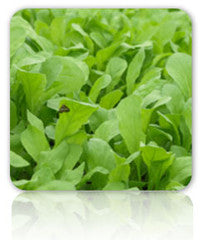
1. Arugula - Classic Roquette (Appx. 150 seeds)
- Arugula can usually be harvested as early as 30-40 days after planting. The leaves of the Arugula plant add a tangy/peppery flavor to any meal. This Arugula variety is an easy-to-grow green. Plant in the spring and again in the fall. Arugula is one of the easiest leafy greens you can grow.
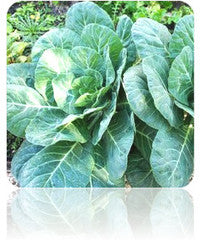
2. Collard - Traditional Georgia Southern (Appx. 50 seeds)
- This is the traditional Collard Green variety popularly grown in the south. Produces large yields of dark blue-green cabbage-like leaves Tolerates heat, humidity, and poor soil conditions.
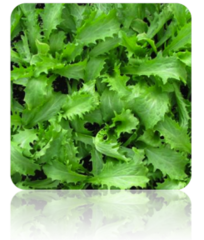
3. Endive - Green Curled (Appx. 100 seeds)
- Endive is a healthy and delicious leafy green. The Green Curled Endive plant produces dark green curly leaves with large tender crisp ribs. Excellent salads and sandwiches. Also good boiled or steamed Extremely easy to grow Endive is rich in many vitamins and minerals, especially in folate and vitamins A and K, and is high in fiber.

4. Kale - Blue Curled Scotch (Appx. 50 seeds)
- The Blue Curled Scotch is an early Kale variety which will produce tasty greens! Excellent in salads or steamed. The blue-green leaves are finely curled and reach up to 12-15" tall! Can handle the cold extremely well. One of the best frost resistant kale varieties available.

5. Kale - Red Russian (Appx. 50 seeds)
- Stems are purple with deep gray-green leaves. The plants mature medium-tall and leaves are tender compared to other kale varieties. Ideal for salads and light cooking. This variety is excellent producer in cooler growing seasons.

6. Lettuce - All Year Round (Appx. 200 seeds)
- As its name suggests, this is a lettuce that can be gown throughout the year. In even some of the the coldest areas across the country, this variety can be grown with some protection with a cloche or cold frame in the cooler months.

7. Lettuce - Gourmet/Mesclun Mix (Appx. 200 seeds)
-
A mixture of favorite lettuce seed varieties from across the spectrum of lettuce types. Plant heavy and start harvest early for young for baby greens then allow some to grow on for plenty of variety for salads. A great way to get a lot out of little space. Perfect for container gardening.

8. Lettuce - Iceberg (Appx. 200 seeds)
- A classic lettuce variety. Iceberg lettuce is most often grown as a leaf vegetable. Mild in flavor, it has been described over the centuries as a cooling counterbalance to other ingredients in a salad. Perfect for burgers and other culinary creations.

9. Lettuce - Classic "Paris Island Cos" (Appx. 135 seeds)
- Large, upright, full-bodied heads with dark-green, slightly savoyed leaves that are mild and sweet. Plant reaches about 10 inches tall. Midribs are crunchy and juicy. Because of their higher chlorophyll content, romaine lettuces are among the most nutritious of all lettuces. Excellent performer in the inter-mountain region. Mosaic tolerant.
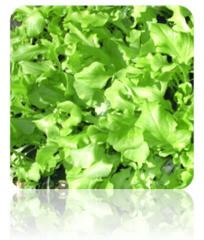
10. Lettuce - Salad Bowl, Green (Appx. 150 seeds)
- The Green Salad Bowl Mix is a really easy-to-grow lettuce variety. Extremely flavorful green leafs. Continues to grow as picked. As outer leaves are picked, inner leaves keep growing. Excellent addition for salads and garnishes

11. Lettuce - Salad Bowl, Red (Appx. 150 seeds)
- The Red Salad Bowl Mix is a really easy-to-grow lettuce variety. Extremely flavorful red leafs. Continues to grow as picked. As outer leaves are picked, inner leaves keep growing. Excellent addition for salads and garnishes.

12. Lettuce - Tom Thumb (Appx. 180 seeds)
- The tom thumb lettuce produces a small, round head with delicate yet delicious leaves. This variety can be planted close together. Ideal for small spaces. Grows well in containers on a patio or windowsill.

13. Mustard - Mizuna (Appx. 50 seeds)
- The Mizuna mustard is a vigorous grower, which produces numerous stalks bearing dark green, deeply cut and fringed leaves. They have a fresh, crisp taste and can be used on their own or cooked with meat. This mustard variety is highly resistant to cold and grows well during the winter months.

14. Mustard - Tendergreen (Appx. 50 seeds)
- A traditional Southern favorite. Plant produces good yields of green mustard leaves. Excellent flavor. Makes a great garnish to any dish. Easy to grow.
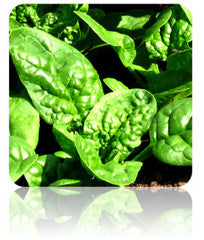
15. Spinach - Bloomsdale (Appx. 70 seeds)
- Bloomsdale Spinach will produce heavy, glossy, dark green leaves. Excellent flavor. Extremely easy to grow. Large, curly dark green leaves. Nice sweet taste.
All-in-One Sprouts/Microgreens Seed Bank w/Sprouting Jar
$6999 USD$7999Unit price /UnavailableDescription
The all-new Micro-Greens & Sprouts Seed Bank includes everything you need to start growing fresh nutrient-rich sprouts in as little as 3 days!
Includes Large Glass Mason JarEach and every living seed will grow into a plant. It's when that seed begins to grow (germinate) that we call the beginning growth stage of the plant a "sprout". This is the practice of germinating seeds to be eaten either raw or cooked. They are a convenient way to have fresh vegetables for salads, or otherwise, in any season and can be germinated at home or produced industrially. Sprouts are said to be rich in digestible energy, vitamins, minerals, amino acids, proteins, and phytochemicals! In as little as 3 days you will be able to start eating your fresh sprouts! Super easy to grow and extremely healthy for you.
Includes:
- 6 of our most popular seed sprouting varieties
- Large glass mason jar and sprouting lid
- Step-by-step sprouting instructions
- Resealable Mylar packaging for long-term seed storage
1. Garlic Chives - Appx. 13,500 seeds!
-
Days before you can eat them | 3-7 days
- Garlic Chives will produce shoots that grow to a mature height of roughly 12 inches tall. Popularly used to flavor potatoes and salads, Chives are not only tasty, but are also attractive as well. Each plant displays white colored flowers atop slender stems / shoots. Flowering much later than traditional Chives, it’s Garlic twins will bloom within the heat of the summer months. The shoots, once cut will add a slight garlic & onion flavor to any dish that they are added to. The flowers also add a mild onion/garlic flavor and can be used as a garnish.
2. Clover Appx. 45,000 seeds!-
Days before you can eat them | 2-5 days
- If you like alfalfa sprouts then you’ll love the sweet mild flavor of red clover sprouts from clover seed. These sprouts are actually larger and more flavorful than alfalfa sprouts and make a great addition to sandwiches and salads.
3. Radish Appx. 5,000 seeds!
- They're easy to grow - and - taste great. Hints of pepper flavor. Radish sprouts have gained popularity in recent years.
4. Adzuki Beans Appx. 800 seeds! -
Days before you can eat them | 3 - 5 days
- The Adzuki Bean (Vigna angularis) has been grown in the Far East for centuries. Adzuki beans are one of Japan’s largest crops, with annual consumption of over 120,000 metric tons.Adzuki beans are often sprouted for only one day, mixed with other sprouts and called a "Crispy Mix" or "Crunchy Mix."They are commonly used throughout Asia in a variety of ways.
5. Green Pea Shoots Appx. 500 seeds!- Ready to eat as a sprout just a soon as they pop.
Sweet and delicious in salads and casseroles.
6. Red Kale Micro-greens Appx. 23,000 seeds! -
Days before you can eat them | appx. 5 to 7 days
- Kale micro-green sprouts are really easy to grow. Just let them grow until you see the first set of true leaves. Perfect for a micro-green salad. Makes a great addition to many culinary dishes. These sprouts have a mildly sweet flavor.
Steps for Sprouting Seeds
The easiest method of growing sprouts is to use a Mason jar. The key is to provide plenty of fresh air to enter the jar and only cover the top with a mesh screen.
Step 1: Soaking
For a quart-sized jar, put 1 ½ to 2 tablespoons of small seeds (up to 1 cup if using larger seeds like green peas or garbanzo) in the sprouting jar. Cover top of jar with cloth or sprouting lid and rinse the seeds in warm (not hot) water. Drain and refill so that water is about an inch above the seeds. Let the seeds soak 8-12 hours (overnight). Protect from light by covering with a dish towel or placing in a cupboard.
Step 2: Rinsing
Rinse 2 to 3 times per day for 2 to 3 days. After thoroughly draining the rinse water, lay the jar on its side to spread out the seeds. Do not expose to light. After 2 to 3 days the sprouts should be filling up the jar.
Things to Remember:1. Rinse often (2-3 times/day).
2. Keep them moist, not wet.
3. Keep them at room temperature.
4. Give them air to breathe.
5. Don't grow too many in one container.
6. Keep them in a dark place.
All-in-One Sprouts/Microgreens Variety Pack
$3499 USDUnit price /UnavailableDescription
All-in-One Sprouts Variety Pack includes a large assortment of our 5 most popular sprouts varieties. Grow your own organic sprouts indoors! It's very easy to do. Seed are all individually packaged. Packaged with zip-lock system for long-term storage and maximum seed protection.
Includes all of the following 5 varieties:

1. Sprouts - Onion (appx. 10,400 seeds!)
- Mustard is a member of the crucifer family.
- Mustard greens are a popular dish in the Southern U.S. and are an excellent source of vitamins A and C.
- Mustard sprouts have a strong spicy flavor and are usually blended with alfalfa or clover sprouts.

2. Sprouts - Alfalfa (appx. 30,400 seeds!)
- Alfalfa is one of the healthiest and easiest sprouts you can grow!
- Extremely high in protein, calcium, plus other minerals and vitamins in the B group, vitamin C, vitamin E, and vitamin K.
- Alfalfa is extremely easy to grow.

3. Sprouts - Daikon Radish (appx. 4,620 seeds!)
- They're easy to grow - and - taste great.
- Hint of pepper flavor.

4. Sprouts - Clover (appx. 11,000 seeds!)
- If you like alfalfa sprouts then you’ll love the sweet mild flavor of red clover sprouts from clover seed.
- Larger and more flavorful than alfalfa sprouts and make a great addition to sandwiches and salads.
- Thought to have powerful anti-cancer properties.

5. Sprouts - Broccoli (appx. 9,600 seeds!)- Days before you can eat them | 3-7 days
- Description | An easy to grow sprout that is extremely nutritious. Broccoli sprouts are 10x - 100x higher in some cancer fighting compounds than the mature vegetable.
- Mustard is a member of the crucifer family.
Angelica (Wild Celery / Holy Ghost)
From $099 USDUnit price /UnavailableDescription
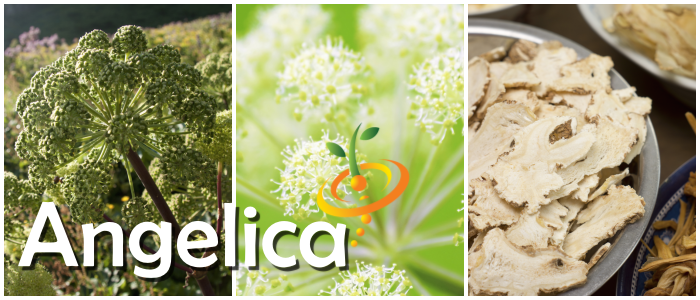
Angelica (Angelica archangelica), also called Wild Celery and Holy Ghost, is a fragrant herb in the carrot family. Like a carrot, it’s a biennial that flowers the second year, and it has a long thick root. But it’s not a carrot. For starters, it tastes like licorice. And the plant can grow to 4'-6' tall. It prefers cooler weather and growing near running water, so congrats if you’re gardening along the riverbanks of Utopia. The rest of us can just grow it in dappled shade and make sure the soil doesn’t dry out.
The flowers, leaves, seeds, stems, and roots are all edible. Peel the young, hollow, purple-tinged stems and use like celery, use the leaves like spinach, or make a tea from the leaves, flowers, seeds, and roots.
As a medicinal herb, Angelica has been used to treat anxiety, bladder infections, bronchitis, colds, cough, fever, flatulence, indigestion, insomnia, heartburn, lack of appetite, poor circulation, respiratory issues, typhus, and upset stomach.
- Mild licorice flavor
- All parts are edible
- Culinary and medicinal
- Good fresh and cooked
As a companion plant, it attracts all sorts of friendly pollinators and beneficial insects.
⚠️ Medicinal properties are presented as information only, and are not a recommendation or prescription for use. Consult a medical professional before using any herb medicinally.
SEED PLANTING TIPS
- Botanical name: Angelica archangelica
- Life cycle: Herbaceous biennial
- Hardiness zones: 4-8
- Planting season: Spring, fall
- Days to maturity: 1-2 years; can begin harvesting when 6" tall
- Depth to plant seeds: Lightly cover - seeds need light to germinate
- Days to germinate (sprout): 14-28 days
- Germination soil temps: 60F-65F
- Spacing between plants: 18"-24" apart
- Spacing between rows: 24"-36" apart
- # of plants per sq. ft.: Appx. 1 plant per 2 sq. ft.
- Soil types: Clay, sandy, loamy, silty, moist, well-drained
- Soil pH: 4.5-7.4
- Sun needs: Full sun, part shade
- Water needs: High - keep soil moist
- Cold stratify: Yes
- Frost tolerant: Yes
- Heat tolerant: No
- Drought tolerant: No
- Deer resistant: No
- Culinary use: Yes
- Medicinal use: Yes
- From $299 USDUnit price /Unavailable
Description

Anise (Pimpinella anisum), also called Aniseed, is a sweet, aromatic annual in the parsley family.
The leaves and flowers are lacy, delicate, and delicious, and plants can grow 2'-3' tall.
With a fresh licorice flavor, use as you would Tarragon and Fennel in both savory meat and vegetable dishes, salads and dressings, and sweet baked goods, such as biscotti.
Chew the seeds for a natural breath freshener and digestif. Its aromatic seeds are also used for cooking and herbal medicine.
You may be familiar with the anise flavor if you've had absinthe, as anise seeds are the basis for this famous alcoholic beverage.
- Licorice flavor
- Edible seeds and leaves
- Culinary and medicinal
- Good for containers
As a companion plant, it attracts pollinators and beneficial insects, and repels aphids, cabbage moths, cabbage white fly, cabbage worms, slugs, and snails, but is strangely irresistible to bears, deer, dogs, and mice.
As a medicinal herb, Anise has been used internally to treat bad breath, bloating, constipation, cough, flatulence, hot flashes, indigestion, lack of appetite, migraine headaches, and upset stomach, and externally to treat bronchitis, eye pain, and swelling.
⚠️ Medicinal properties are presented as information only, and are not a recommendation or prescription for use. Consult a medical professional before using any herb medicinally.
- From $299 USDUnit price /Unavailable
Description

Roquette Arugula (also called Rocket) is one of the easiest leafy greens you can grow, and can be harvested as early as 20 days after planting. The young seed pods, flowers, leaves, and mature seeds are all edible. A member of the mustard family, the leaves of the Arugula plant add a deliciously tangy/peppery flavor to any meal.
- Easy to grow
- Entire plant is edible
- Frost tolerant
- Quick to mature — 20 days for baby greens!
Shop all Arugula Seeds Shop Good Companion Plants for Arugula 📚 Grow Guide: Arugula Basil, Cinnamon (Mexican Basil)
From $299 USDUnit price /UnavailableDescription
Cinnamon Basil, also called Mexican Basil, has glossy, deep green leaves that turn reddish at the tips when mature, and dark cinnamon-colored stems. Its warm, sweet cinnamon-anise flavor is especially nice in ham and pork dishes, apple pie and other desserts, and kombucha.
By far the most popular variety and possibly one of the most fragrant, this basil grows easily. Its aroma will remind you of sweet cinnamon and it is popular for use in hot drinks and paired with fresh fruit.
This sweet basil is exotic and has dark green leaves with purplish-red stems and purple blooms. It's spicy and has a cinnamon-like taste and scent. If you like making homemade potpourris or dried flower arrangements try adding some cinnamon basil!The violet flower spikes make an unusual garnish or addition to salads. Harvest the leaves and stems from the top part of the plant, and pinch off edible flower buds as they appear, which prevents the leaves from turning bitter, and signals the plant to branch out and grow more leaves, making a bushier plant.
The more you harvest, the more it grows!
- Cinnamon-anise flavor
- Tons of medicinal benefits!
- Good for indoor gardens
- Good for containers
As a medicinal herb, Basil has been used internally to treat anxiety, colds, colic, cough, depression, diarrhea, fever, flatulence, flu, indigestion, insomnia, intestinal parasites and worms, exhaustion, gastric pain, gonorrhea, lactation problems, migraine headache, nausea, stomach cramps, sore throat, and vomiting, and externally to treat acne, insect bites and stings, loss of smell, skin problems, snake bites.
⚠️ Do not use medicinally while pregnant.
⚠️ Medicinal properties are presented as information only, and are not a recommendation or prescription for use. Consult a medical professional before using any herb medicinally.
Plant Basil in your garden to attract hummingbirds, pollinators, and other beneficial insects.
Basil is also know to repel aphids, asparagus beetles, cabbage moths, cabbage white butterfly, cabbage worms, carrot rust fly, flies, maggots, mice, mosquitoes, spider mites, thrips, and tomato hornworms!
Shop all Basil Seeds Shop Good Companion Plants for Basil 📚 Grow Guide: Basil Health Benefits of Cinnamon Basil
Cinnamon basil is a must have, medicinal herb. It offers anti-inflammatory benefits and can relieve symptoms of arthritis! If you suffer from allergies, diabetes, colds, the flu, or infertility, some would swear by the benefits of consuming cinnamon basil and how it's improved their health. It is even used in the treatment of some cancers. It naturally boosts your immune system and is a known anti-bacterial and anti-viral. Are you growing this yet?...because you should be!
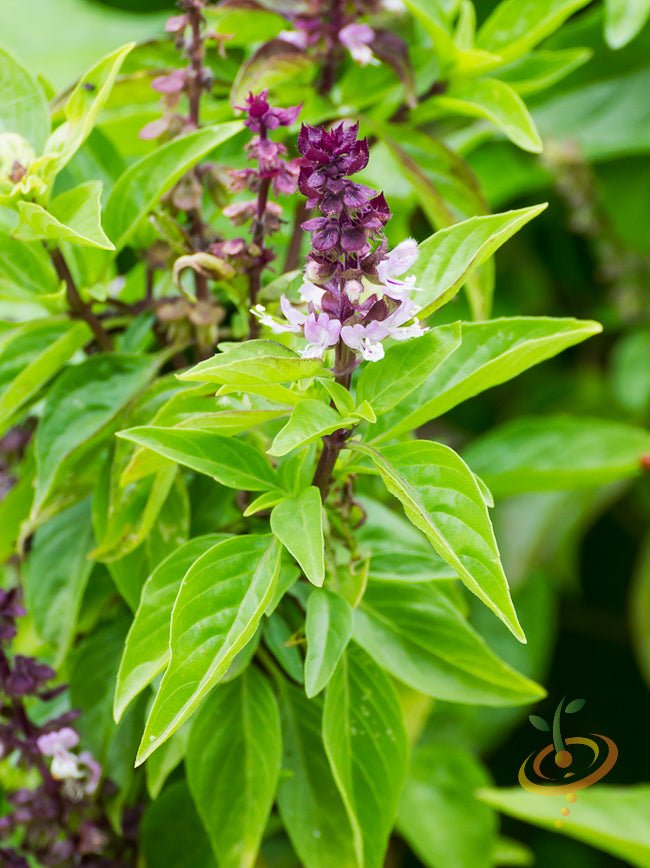
Ways to Consume Cinnamon BasilUse this exotic and fragrant basil in any recipe that calls for basil. The sweet flavor is great when paired with other fruity herbs. Pick the leaves when small and tender and use them in your favorite recipes or put them in bottles of olive oil to make cinnamon flavored oil. Cinnamon basil pairs harmoniously with apple pie filling, apple sauce, pork or ham dishes. Add frozen basil leaves to soups or sauces. Cinnamon basil can also be used to make refreshing teas, hot or cold!
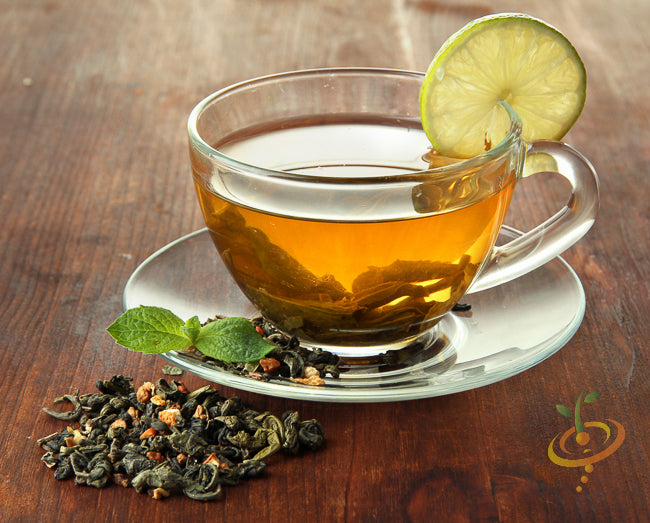

See Basil Recipes & Growing Tips on our Pinterest Board
Shop all Basil Seeds Shop Good Companion Plants for Basil 📚 Grow Guide: Basil - From $299 USDUnit price /Unavailable
Description
Dark Opal Purple Basil is a dark, fragrant beauty with its glossy, deep black-purple leaves that shimmer with iridescence in bright light, plum-colored stems, and edible violet flower spikes that make a spectacular garnish. A 1962 All-America Selections Winner! This annual basil plant produces extremely fragrant dark purple leaves. It can be used as a garnish or to make flavored vinegars. This basil drys excellently and is very easy to grow. Gardening in a small space or wanting to use a container? This variety grows great in them!Use it to add sweet, intense anise flavor and a dreamy purple color to pesto or bruschetta, or mix it into a moody Caprese salad with Black Krim Tomatoes.
Harvest the leaves and stems from the top part of the plant, and pinch off edible flower buds as they appear, which prevents the leaves from turning bitter, and signals the plant to branch out and grow more leaves, making a bushier plant.
The more you harvest, the more it grows!
- Sweet, intense anise flavor
- Slow to bolt (flower)
- 1962 All-America Selections (AAS) Winner
- Good for containers
- Tons of medicinal benefits!
As a medicinal herb, Basil has been used internally to treat anxiety, colds, colic, cough, depression, diarrhea, fever, flatulence, flu, indigestion, insomnia, intestinal parasites and worms, exhaustion, gastric pain, gonorrhea, lactation problems, migraine headache, nausea, stomach cramps, sore throat, and vomiting, and externally to treat acne, insect bites and stings, loss of smell, skin problems, snake bites.
⚠️ Do not use medicinally while pregnant.
⚠️ Medicinal properties are presented as information only, and are not a recommendation or prescription for use. Consult a medical professional before using any herb medicinally.
Plant Basil in your garden to attract hummingbirds, pollinators, and other beneficial insects.
Basil is also know to repel aphids, asparagus beetles, cabbage moths, cabbage white butterfly, cabbage worms, carrot rust fly, flies, maggots, mice, mosquitoes, spider mites, thrips, and tomato hornworms!

What is Dark Opal Purple Basil?
This sweet and very popular variety of basil has gorgeous purple-black glossy foliage and a delicious aroma. It's eye catching and a beautiful, colorful garden plant. This basil produces small to medium sized, tender leaves. It is slow to bolt and grows at a steady pace. The dark purple has a green metallic undertone or sheen and in bright light it can appear flat and open.
Health Benefits of Dark Opal Purple BasilDark Opal Purple Basil has a variety of medicinal benefits and has been known to improve digestive functions, treat acne and insect bites, improve nausea, and work as a sedative for muscle spasms and cramps.

Ways to Consume Dark Opal Purple BasilLike many basil varieties, Dark Opal Purple Basil has a degree of licorice flavor, and it is used in the culinary world as an attractive garnish with good flavor. Use this herb fresh or dried and even frozen. It works wonderfully in salads and on sandwiches. The uses for this herb are endless and everyone should take advantage of this fresh and spicy leaf.

See Basil Recipes & Growing Tips on our Pinterest Board
Shop all Basil Seeds Shop Good Companion Plants for Basil 📚 Grow Guide: Basil - From $299 USDUnit price /Unavailable
Description
Genovese Basil, also called Sweet Basil, has large, tender, fragrant leaves and sweet, spicy anise flavor. The best basil for pesto. The flower spikes dotted with tiny white edible flowers make a delicate garnish or salad addition. This heat-loving herb is a reliable producer and all-around great Italian basil.
Genovese Basil is a classic! It's prized for being sweet with undertones of a spicy flavor. You can't beat its aroma. These plants grow anywhere from 18"-24" inches and is the variety of choice for making pesto and adding to pizzas.Use it in pesto, pasta and pizza sauce, Caprese salad, antipasto, curries, cocktails, smoothies, dressing, herb butter, oil, vinegar, and herbal tea.
Harvest the leaves and stems from the top part of the plant, and pinch off edible flower buds as they appear, which prevents the leaves from turning bitter, and signals the plant to branch out and grow more leaves, making a bushier plant.
The more you harvest, the more it grows!
- Sweet and spicy
- Grows 2'-3' tall
- Besto for pesto
- Good for containers
- Tons of medicinal benefits!
As a medicinal herb, Basil has been used internally to treat anxiety, colds, colic, cough, depression, diarrhea, fever, flatulence, flu, indigestion, insomnia, intestinal parasites and worms, exhaustion, gastric pain, gonorrhea, lactation problems, migraine headache, nausea, stomach cramps, sore throat, and vomiting, and externally to treat acne, insect bites and stings, loss of smell, skin problems, snake bites.
⚠️ Do not use medicinally while pregnant.
⚠️ Medicinal properties are presented as information only, and are not a recommendation or prescription for use. Consult a medical professional before using any herb medicinally.
As a companion plant, it attracts hummingbirds, pollinators, and beneficial insects, and repels asparagus beetles, cabbage moths, cabbage white fly, cabbage worms, carrot rust fly, flies, maggots, mice, mosquitoes, spider mites, thrips, and tomato hornworms.
Shop all Basil Seeds Shop Good Companion Plants for Basil 📚 Grow Guide: Basil

What is Genovese Basil?
The most commonly used basil variety for making pesto, you can harvest these leaves as soon as they are large enough to consume. Genovese basil is also known as "Sweet Basil" and a common ingredient to all Italian dishes. The leaves are spoon shaped, glossy and a dark green shade. It grows best in organic-rich and well drained soil and is an easy to grow annual herb that thrives in areas that remain above 50 degrees Fahrenheit.

Health Benefits of Genovese BasilGenovese basil is a known health tonic for expecting mothers and when mixed with tea it increases lactation in mothers. It is also a nerve tonic and young children are sometimes encouraged to chew on the leaves of basil because it stimulates brain cells and can increase memory.

Ways to Consume Genovese BasilThe most popular use is in italian dishes and sauces, especially in genovese sauce and pesto. Genovese Basil goes great in caprese salads and on raw tomatoes for a light, healthy "summery" treat. Mix basil leaves with olive oil and freeze in ice-cube trays for flavored oils when cooking.

See Basil Recipes & Growing Tips on our Pinterest Board
Shop all Basil Seeds Shop Good Companion Plants for Basil 📚 Grow Guide: Basil - From $299 USDUnit price /Unavailable
Description
Greek Basil is a small-leaf dwarf variety that grows into a tight dome, about 1’ tall and wide. A great one for containers, hanging baskets, and indoor gardens. The bright green, oval leaves and soft stems have hints of clove and anise, and keep their flavor when dried. Use this variety to flavor herb butters and vinaigrettes, and the edible flowers as a garnish or salad green.Harvest the leaves and stems from the top part of the plant, and pinch off edible flower buds as they appear, which prevents the leaves from turning bitter, and signals the plant to branch out and grow more leaves, making a bushier plant.
The more you harvest, the more it grows!
- Basil-clove-anise flavor
- Compact plant
- Good for indoor gardens
- Good for containers
- Tons of medicinal benefits!
As a medicinal herb, Basil has been used internally to treat anxiety, colds, colic, cough, depression, diarrhea, fever, flatulence, flu, indigestion, insomnia, intestinal parasites and worms, exhaustion, gastric pain, gonorrhea, lactation problems, migraine headache, nausea, stomach cramps, sore throat, and vomiting, and externally to treat acne, insect bites and stings, loss of smell, skin problems, snake bites.
⚠️ Do not use medicinally while pregnant.
⚠️ Medicinal properties are presented as information only, and are not a recommendation or prescription for use. Consult a medical professional before using any herb medicinally.
As a companion plant, it attracts hummingbirds, pollinators, and beneficial insects, and repels asparagus beetles, cabbage moths, cabbage white butterfly, cabbage worms, carrot rust fly, flies, maggots, mice, mosquitoes, spider mites, thrips, and tomato hornworms.
Shop all Basil Seeds Shop Good Companion Plants for Basil 📚 Grow Guide: Basil


See Basil Recipes & Growing Tips on our Pinterest Board
Shop all Basil Seeds Shop Good Companion Plants for Basil 📚 Grow Guide: Basil - From $299 USDUnit price /Unavailable
Description
Enjoy some of our most popular varieties of Basil Herbs. This is a special blend of basil varieties we carry, sure to be a show stopper! You'll enjoy a wide variety of Basil plants with incredible fragrance and great flavors! Very easy to grow and extremely popular.
Best Seller!
See Basil Recipes & Growing Tips on our Pinterest Board:
Follow SeedsNow.com's board Basil on Pinterest.
Shop all Basil Seeds Shop Good Companion Plants for Basil 📚 Grow Guide: Basil - From $299 USDUnit price /Unavailable
Description
Italian Large Leaf Basil has soft, crinkled, bright green 2"-4" leaves, and a sweeter flavor than the Genovese Basil.Aromatic and delicious, use it to flavor herbal tea, herb butter, oil, vinegar, pasta and pizza sauce, antipasto, smoothies, curries, cocktails, Caprese salad, dressing, and pesto. The edible flower spikes make a beautiful garnish. Reliable producer and all-around great Italian basil.
Harvest the leaves and stems from the top part of the plant, and pinch off edible flower buds as they appear, which prevents the leaves from turning bitter, and signals the plant to branch out and grow more leaves, making a bushier plant.
The more you harvest, the more it grows!
- Sweet and spicy with less clove
- Genovese type
- Grows 1'-2' tall
- Good for containers
- Tons of medicinal benefits!
As a medicinal herb, Basil has been used internally to treat anxiety, colds, colic, cough, depression, diarrhea, fever, flatulence, flu, indigestion, insomnia, intestinal parasites and worms, exhaustion, gastric pain, gonorrhea, lactation problems, migraine headache, nausea, stomach cramps, sore throat, and vomiting, and externally to treat acne, insect bites and stings, loss of smell, skin problems, snake bites.
YIELD Do not use medicinally while pregnant.
YIELD Medicinal properties are presented as information only, and are not a recommendation or prescription for use. Consult a medical professional before using any herb medicinally.
As a companion plant, Basil attracts hummingbirds, pollinators, and beneficial insects, and repels asparagus beetles, cabbage moths, cabbage white butterfly, cabbage worms, carrot rust fly, flies, maggots, mice, mosquitoes, spider mites, thrips, and tomato hornworms.
Shop all Basil Seeds Shop Good Companion Plants for Basil 📚 Grow Guide: Basil

The Italian Large Leaf Basil plant will produce medium to large leaves that can measure up to 4" long! It is of heirloom variety and is extremely fragrant and used widely in the culinary industry. If you're a lover of basil, this would be a good variety to plant in your garden.

What is Italian Large Leaf Basil?
Italian Large Leaf Basil is an annual plant that will produce edible and fragrant leaves, flowers, and continue to put off a few more leaves through the process of ending it's life cycle. This basil grows well in "filtered light" (meaning near a bright window or under a tree), and it grows best in 50-90 degree weather. Warm, but not too warm.

Health Benefits of Italian Large Leaf BasilItalian Large Leaf Basil has anti-bacterial properties and anti-inflammatory effects. It's been known to help people with inflammatory health problems like arthritis or IBS. Basil also contains properties that mimic food preservatives so it makes good sense to try and include more basil into the foods you prepare at home. Basil will help naturally preserve them so they'll be safer, longer. Basil also contains all the good stuff needed for better cardiovascular health.

Ways to Consume Large Leaf Italian Basil
Use this variety of basil in your favorite Neapolitan cuisine dishes! Use the extra large leaves, fresh or dried, in tomato dishes, pasta sauces, vegetable dishes and soups.


See Basil Recipes & Growing Tips on our Pinterest Board
Shop all Basil Seeds Shop Good Companion Plants for Basil 📚 Grow Guide: Basil - From $299 USDUnit price /Unavailable
Description
Lemon Basil, also called Hoary Basil (for its fuzzy stems), is a hybrid cross between traditional basil and lime basil.The bright green leaves have a sweet lemony aroma and a tangy lemon-anise flavor that’s best used fresh in seafood dishes, fruit salads, lemonade, cocktails, and salad dressings. Add at the end of cooking to preserve the citrus flavor, then garnish with the edible flowers.
Harvest the leaves and stems from the top part of the plant, and pinch off edible flower buds as they appear, which prevents the leaves from turning bitter, and signals the plant to branch out and grow more leaves, making a bushier plant.
The more you harvest, the more it grows!
- Tangy lemon-anise flavor
- Culinary and medicinal
- Good for indoor gardens
- Good for containers
- Tons of medicinal benefits!
As a medicinal herb, Basil has been used internally to treat anxiety, colds, colic, cough, depression, diarrhea, fever, flatulence, flu, indigestion, insomnia, intestinal parasites and worms, exhaustion, gastric pain, gonorrhea, lactation problems, migraine headache, nausea, stomach cramps, sore throat, and vomiting, and externally to treat acne, insect bites and stings, loss of smell, skin problems, snake bites.
⚠️ Do not use medicinally while pregnant.
⚠️ Medicinal properties are presented as information only, and are not a recommendation or prescription for use. Consult a medical professional before using any herb medicinally.
As a companion plant, Basil attracts hummingbirds, pollinators, and beneficial insects, and repels asparagus beetles, cabbage moths, cabbage white butterfly, cabbage worms, carrot rust fly, flies, maggots, mice, mosquitoes, spider mites, thrips, and tomato hornworms.
Shop all Basil Seeds Shop Good Companion Plants for Basil 📚 Grow Guide: Basil
Health Benefits of Lemon Basil
Basil is a known health tonic for expecting mothers and when mixed with tea it increases lactation in mothers. It is also a nerve tonic and young children are sometimes encouraged to chew on the leaves of basil because it stimulates brain cells and can increase memory.

See Basil Recipes & Growing Tips on our Pinterest Board
Shop all Basil Seeds Shop Good Companion Plants for Basil 📚 Grow Guide: Basil - From $299 USDUnit price /Unavailable
Description
Let us tell you about Lettuce Leaf Basil. It’s a lovely Italian basil that grows huge leaves as big as your hand, with a flavor that’s sweeter and less spicy than other basils. Its crinkles hold onto dressing in salads, you need only one leaf for a sandwich or wrap, and you can use the rest as you would any other basil. Save the edible flower spikes to garnish seafood dishes and cocktails.Harvest the leaves and stems from the top part of the plant, and pinch off edible flower buds as they appear, which prevents the leaves from turning bitter, and signals the plant to branch out and grow more leaves, making a bushier plant. The more you harvest, the more it grows!
- Sweet and mild
- Huge 5"-6" leaves
- Grows 1'-2' tall
- Good for containers
- Tons of medicinal benefits!
As a medicinal herb, Basil has been used internally to treat anxiety, colds, colic, cough, depression, diarrhea, fever, flatulence, flu, indigestion, insomnia, intestinal parasites and worms, exhaustion, gastric pain, gonorrhea, lactation problems, migraine headache, nausea, stomach cramps, sore throat, and vomiting, and externally to treat acne, insect bites and stings, loss of smell, skin problems, snake bites.
⚠️ Do not use medicinally while pregnant.
⚠️ Medicinal properties are presented as information only, and are not a recommendation or prescription for use. Consult a medical professional before using any herb medicinally.
As a companion plant, Basil attracts hummingbirds, pollinators, and beneficial insects, and repels asparagus beetles, cabbage moths, cabbage white butterfly, cabbage worms, carrot rust fly, flies, maggots, mice, mosquitoes, spider mites, thrips, and tomato hornworms.
Shop all Basil Seeds Shop Good Companion Plants for Basil 📚 Grow Guide: Basil
Health Benefits of Genovese Basil
Basil is a known health tonic for expecting mothers and when mixed with tea it increases lactation in mothers. It is also a nerve tonic and young children are sometimes encouraged to chew on the leaves of basil because it stimulates brain cells and can increase memory.

See Basil Recipes & Growing Tips on our Pinterest Board
Shop all Basil Seeds Shop Good Companion Plants for Basil 📚 Grow Guide: Basil - From $299 USDUnit price /Unavailable
Description
Licorice Basil is a type of Thai basil with a pleasant, sweet licorice flavor. Beautiful as a fragrant and ornamental accent throughout the garden, and delicious in salads, baked goods, and pasta sauce. It’s also pleasant to look at with deep green leaves that sometimes show a burgundy tinge, plum-colored stems, and lavender flower spikes that make a fun garnish for any salad, dish, or drink.Harvest the leaves and stems from the top part of the plant, and pinch off edible flower buds as they appear, which prevents the leaves from turning bitter, and signals the plant to branch out and grow more leaves, making a bushier plant.
The more you harvest, the more it grows!
- Sweet, pleasant licorice flavor
- Thai basil type
- Edible ornamental
- Good for containers
- Tons of medicinal benefits!
As a medicinal herb, Basil has been used internally to treat anxiety, colds, colic, cough, depression, diarrhea, fever, flatulence, flu, indigestion, insomnia, intestinal parasites and worms, exhaustion, gastric pain, gonorrhea, lactation problems, migraine headache, nausea, stomach cramps, sore throat, and vomiting, and externally to treat acne, insect bites and stings, loss of smell, skin problems, snake bites.
⚠️ Do not use medicinally while pregnant.
⚠️ Medicinal properties are presented as information only, and are not a recommendation or prescription for use. Consult a medical professional before using any herb medicinally.
As a companion plant, it attracts hummingbirds, pollinators, and beneficial insects, and repels asparagus beetles, cabbage moths, cabbage white butterfly, cabbage worms, carrot rust fly, flies, maggots, mice, mosquitoes, spider mites, thrips, and tomato hornworms.
Shop all Basil Seeds Shop Good Companion Plants for Basil 📚 Grow Guide: Basil 
This basil variety produces lovely and flavorful green leaves with purple accents. It has a strong, but enjoyable licorice flavor and can grow up to 24" tall.

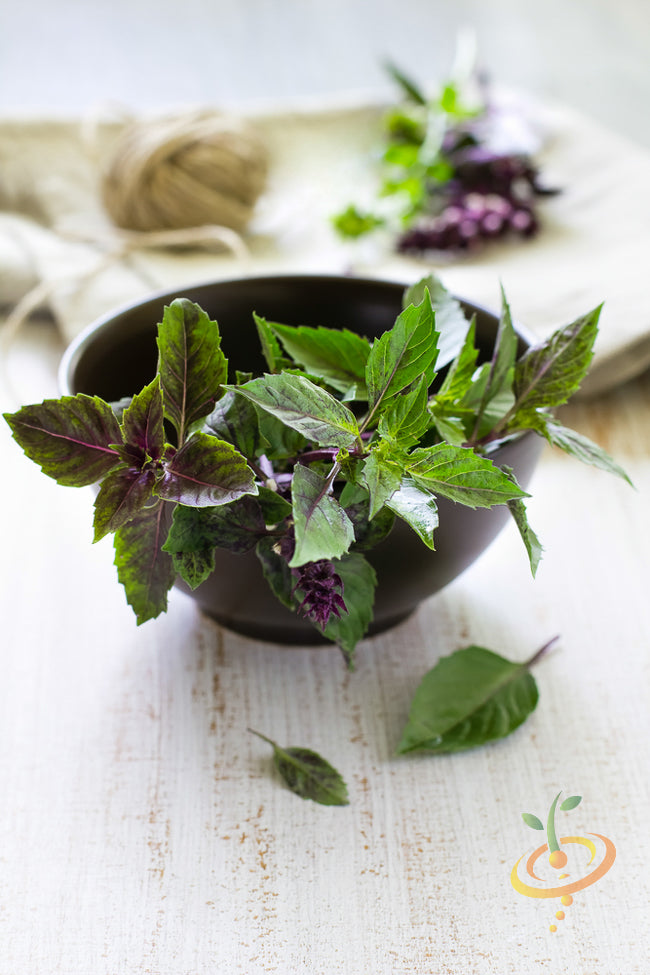
What is Licorice Basil?
This basil is a type of Thai Basil, also known as anise basil. It has strong licorice and anise flavors, qualities and aromatics. It's known to be slightly "lanky" with pointed green leaves with signature purple flowers. Both the leaves and flowers are edible on this plant.
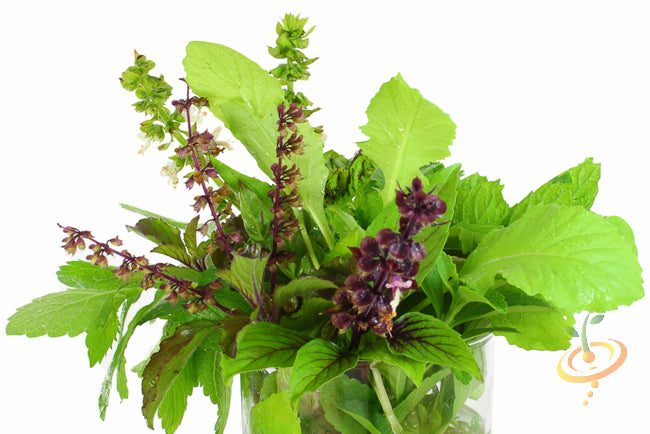
Health Benefits of Licorice Basil
Licorice Basil can be used for treating the common cold, the flu, diabetes, asthma, bronchitis, earaches, headaches, upset stomachs, heart disease, fever, and more. It promotes longevity but something you may not know is that its an excellent mosquito repellent!

Ways to Consume Licorice BasilWhen Licorice Basil leaves are crushed, they burst with intense basil and licorice aromas. Fragrant and floral, the spicy paste is a condiment for multiple dishes. This basil is best when mixed with other ingredients to tame it's powerful one-dimensional notes.

See Basil Recipes & Growing Tips on our Pinterest Board
Shop all Basil Seeds Shop Good Companion Plants for Basil 📚 Grow Guide: Basil - From $299 USDUnit price /Unavailable
Description
Lime Basil is as fresh and uplifting as it sounds. The bright green leaves are infused with a zesty lime fragrance and tangy flavor that’s best used fresh in coconut-heavy Asian dishes, seafood dishes, fruit salads, limeade, cocktails, and salad dressings. Add at the end of cooking to preserve the citrus flavor, then garnish with the edible flowers.Harvest the leaves and stems from the top part of the plant, and pinch off edible flower buds as they appear, which prevents the leaves from turning bitter, and signals the plant to branch out and grow more leaves, making a bushier plant.
The more you harvest, the more it grows!
- Fresh, zesty lime-anise flavor
- Culinary and medicinal
- Good for indoor gardens
- Good for containers
- Tons of medicinal benefits!
As a medicinal herb, Basil has been used internally to treat anxiety, colds, colic, cough, depression, diarrhea, fever, flatulence, flu, indigestion, insomnia, intestinal parasites and worms, exhaustion, gastric pain, gonorrhea, lactation problems, migraine headache, nausea, stomach cramps, sore throat, and vomiting, and externally to treat acne, insect bites and stings, loss of smell, skin problems, snake bites.
⚠️ Do not use medicinally while pregnant.
⚠️ Medicinal properties are presented as information only, and are not a recommendation or prescription for use. Consult a medical professional before using any herb medicinally.
As a companion plant, it attracts hummingbirds, pollinators, and beneficial insects, and repels asparagus beetles, cabbage moths, cabbage white butterfly, cabbage worms, carrot rust fly, flies, maggots, mice, mosquitoes, spider mites, thrips, and tomato hornworms.
Shop all Basil Seeds Shop Good Companion Plants for Basil 📚 Grow Guide: Basil 
The Lime Basil plant is very easy to grow and smells extremely fragrant! It has an amazing lemon scent, perfect for homemade lemonade! Use this in all your favorite culinary creations! It grows to the perfect size for planting in containers, and the aroma of just passing by this herb, will take your senses on an enjoyable ride.

What is Lime Basil?
Lime Basil offers a crisp citrus flavor, with a zesty undertones. It grows as an annual herb with white or lavender flowers. It has many medicinal purposes which makes it an "all around great herb" to grow in your own gardens.
Health Benefits of Lime Basil
From treating some cancers, symptoms of stress, asthma and diabetes, Lime Basil is recognized widely as a medicinal herb.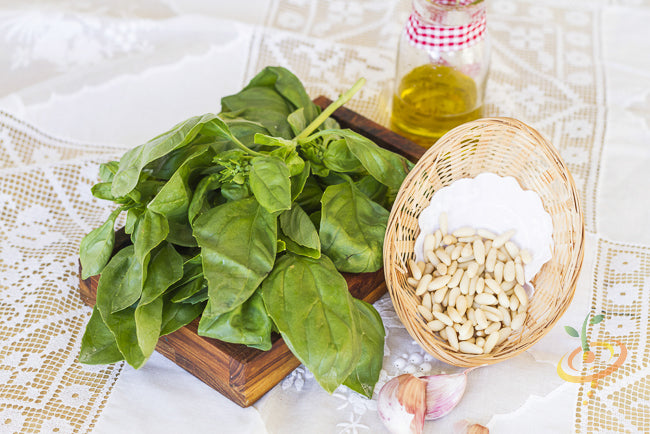
Ways to Consume Lime BasilUsed commonly in fresh cooked recipes, always add it at the last moment so that the cooking doesn't destroy the citrus flavor. It is a favorite ingredient in pesto, and used to thicken soups. Try it with fried chicken, or steeping it in milk to create lovely ice creams or chocolates. Don't toss the flower buds, they are full of flavor and are edible as well.
See Basil Recipes & Growing Tips on our Pinterest Board
Shop all Basil Seeds Shop Good Companion Plants for Basil 📚 Grow Guide: Basil - From $299 USDUnit price /Unavailable
Description
Red Velvet Leaf Basil is a delight for all of your senses. When you see the firm, smooth, deep burgundy leaves, you must touch them, which releases a divine anise fragrance that you have to nibble, and then you hear your own sigh of gratitude that this enchanting herb is growing in your garden, producing all summer long.Harvest the leaves and stems from the top part of the plant, and pinch off edible flower buds as they appear, which prevents the leaves from turning bitter, and signals the plant to branch out and grow more leaves, making a bushier plant.
The more you harvest, the more it grows!
- Rich basil flavor
- Culinary, medicinal, and ornamental
- Good for indoor gardens
- Good for containers
- Tons of medicinal benefits!
As a medicinal herb, Basil has been used internally to treat anxiety, colds, colic, cough, depression, diarrhea, fever, flatulence, flu, indigestion, insomnia, intestinal parasites and worms, exhaustion, gastric pain, gonorrhea, lactation problems, migraine headache, nausea, stomach cramps, sore throat, and vomiting, and externally to treat acne, insect bites and stings, loss of smell, skin problems, snake bites.
Works as well with garlic and tomato as it does with honey and fruit, and makes a rich herbal tea. Dress up a Lollo Rossa Lettuce salad with the edible amethyst flowers.
YIELD Do not use medicinally while pregnant.
YIELD Medicinal properties are presented as information only, and are not a recommendation or prescription for use. Consult a medical professional before using any herb medicinally.
As a companion plant, it attracts hummingbirds, pollinators, and beneficial insects, and repels asparagus beetles, cabbage moths, cabbage white butterfly, cabbage worms, carrot rust fly, flies, maggots, mice, mosquitoes, spider mites, thrips, and tomato hornworms.
Shop all Basil Seeds Shop Good Companion Plants for Basil 📚 Grow Guide: Basil 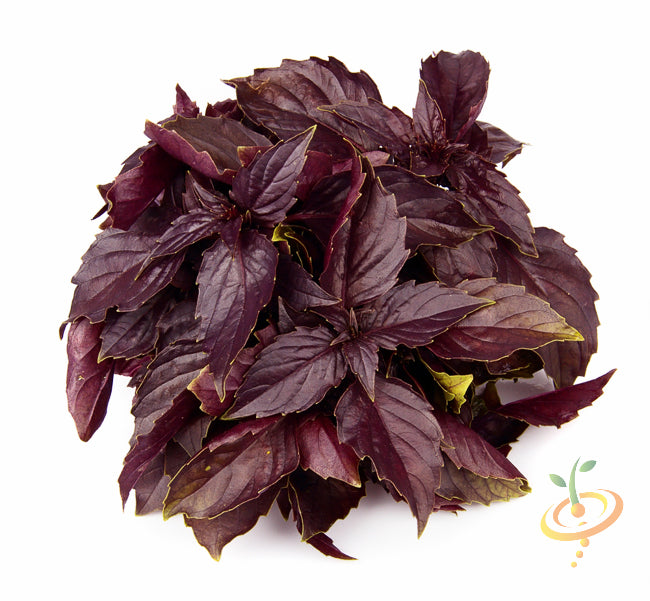 This Red Velvet Leaf Basil plant produces high yields of deed red-colored leaves that are very aromatic. It will produce continuously all season long, and grows perfect in containers.
This Red Velvet Leaf Basil plant produces high yields of deed red-colored leaves that are very aromatic. It will produce continuously all season long, and grows perfect in containers.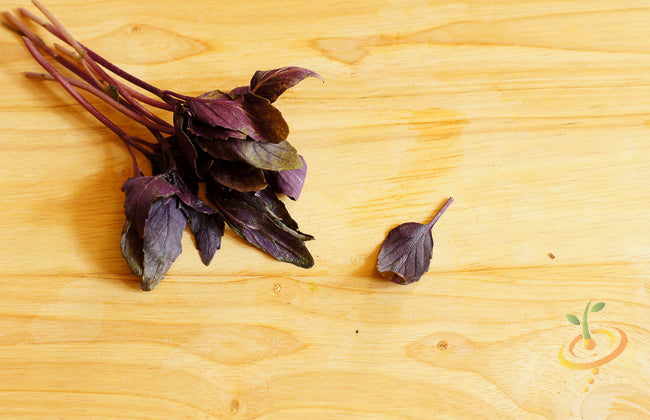

What is Red Velvet Leaf Basil?
This variety of basil boasts unusual reddish-purple leaves and has a stronger flavor than most other types. It is appealing in salads, and used often as a garnish. It's been known to repel mosquitoes too! You can raise this type of basil indoors in a sunny window or outdoors in areas with warm summers.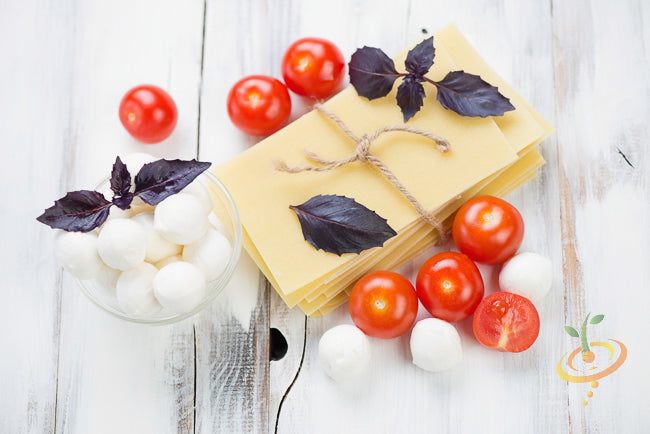
Health Benefits of Red Velvet Leaf Basil
Red Velvet Leaf Basil is packed with phyto-nutrients and health benefits. Rub crushed leaves on your skin to repel mosquitoes. It is a potent anti-oxidant with anti-inflammatory properties as well. This basil is an excellent source of iron and has been known to clear the mind and uplift the spirit.
Ways to Consume Red Velvet Leaf BasilTry Red Velvet Leaf Basil in your favorite salads, fruit jams, sauces, tea or paired with fresh fruit. Garlic flavors pair beautifully with this basil also.
See Basil Recipes & Growing Tips on our Pinterest Board
Shop all Basil Seeds Shop Good Companion Plants for Basil 📚 Grow Guide: Basil - From $299 USDUnit price /Unavailable
Description
Thai Basil has small sturdy leaves that hold up well to high-heat cooking, purple stems, and delicate, edible violet flower spikes that make the whole plant look like a lavender bush when allowed to fully bloom.The spicy clove-anise flavor brings an earthy essence to pesto, Thai curries, stir fries, citrus salads, and cocktails. Elegant in cut flower arrangements, too.
Harvest the leaves and stems from the top part of the plant, and pinch off edible flower buds as they appear, which prevents the leaves from turning bitter, and signals the plant to branch out and grow more leaves, making a bushier plant.
The more you harvest, the more it grows!
- Spicy clove-anise flavor
- Culinary, medicinal, and ornamental
- Good for indoor gardens
- Good for containers
- Tons of medicinal benefits!
As a medicinal herb, Basil has been used internally to treat anxiety, colds, colic, cough, depression, diarrhea, fever, flatulence, flu, indigestion, insomnia, intestinal parasites and worms, exhaustion, gastric pain, gonorrhea, lactation problems, migraine headache, nausea, stomach cramps, sore throat, and vomiting, and externally to treat acne, insect bites and stings, loss of smell, skin problems, snake bites.
⚠️ Do not use medicinally while pregnant.
⚠️ Medicinal properties are presented as information only, and are not a recommendation or prescription for use. Consult a medical professional before using any herb medicinally.
As a companion plant, it attracts hummingbirds, pollinators, and beneficial insects, and repels asparagus beetles, cabbage moths, cabbage white butterfly, cabbage worms, carrot rust fly, flies, maggots, mice, mosquitoes, spider mites, thrips, and tomato hornworms.Shop all Basil Seeds Shop Good Companion Plants for Basil 📚 Grow Guide: Basil 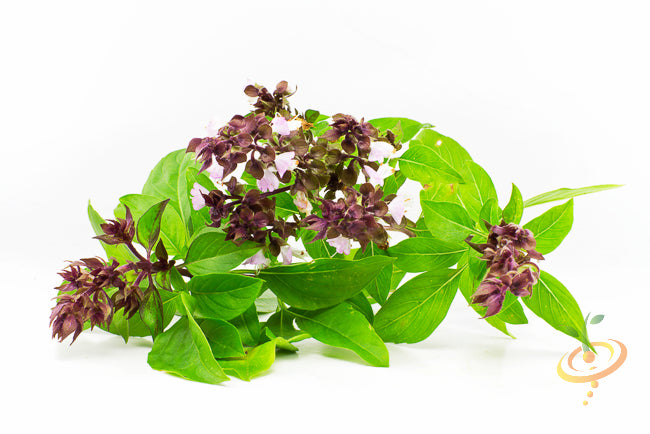
Thai Basil is very fragrant and one of the most available varieties of basil. It has beautiful purple stems with bright green leaves. It is used widely in soups and curries, and other traditional Thai dishes.
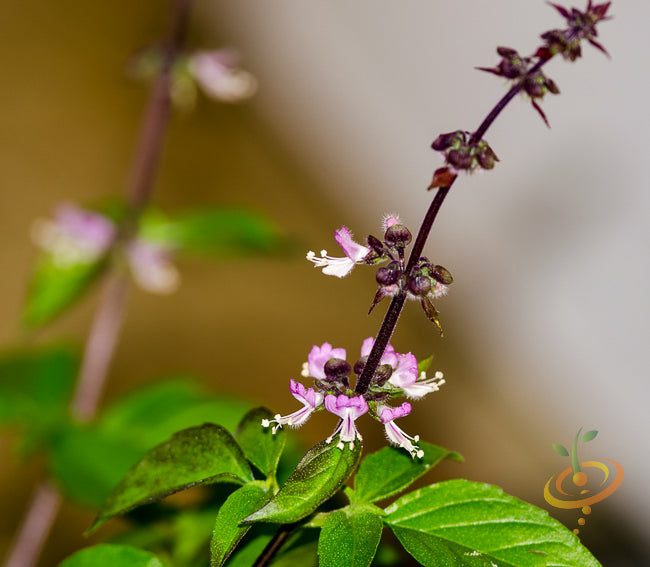
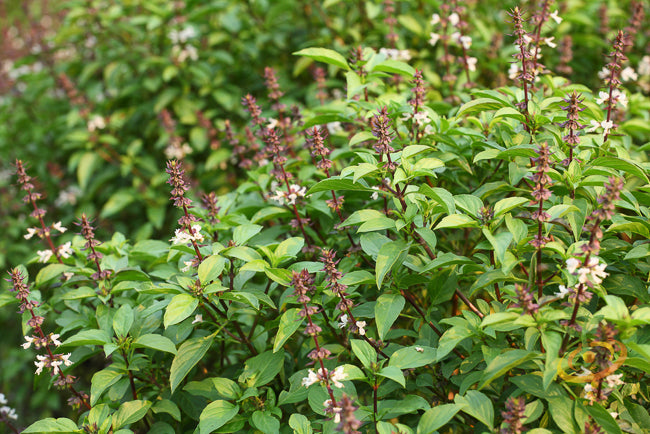
What is Thai Basil?Thai Basil exhibits narrow leaves, with gorgeous purple stems. Sometimes mauve or pink-ish flowers. It needs warm air and sun to do well. This is a wonderful basil to grow if you are a Thai food enthusiast! It is also known as the "holy herb" in many traditions all around the world.

Health Benefits of Thai Basil
Thai Basil is a wonderful blood coagulant, and plays a role in strengthening bones. It contains a ton of iron, vitamin A, and plenty of essential oils.

Ways to Consume Thai BasilUse Thai Basil as a condiment, or a enjoy it as an accompaniment to Pho'. It is slightly anise-flavored so it goes extremely well in soups and curries.

See Basil Recipes & Growing Tips on our Pinterest Board
Shop all Basil Seeds Shop Good Companion Plants for Basil 📚 Grow Guide: Basil Bean - Jicama/Mexican Yam Bean
From $099 USDUnit price /UnavailableDescription
Jicama - Mexican Yam Bean
- Pachyrhizus erosus, commonly known as jicama, Mexican yam bean, or Mexican turnip, is the name of a native Mexican vine, although the name most commonly refers to the plant's edible tuberous root. (source/wikipedia)
- Grows as a large vine.
- Day to Maturity | 80 days
-
Best Months to Plant | [April - June] Beans like sun and water. Give them lots of it and they'll grow fast.
-
Pole Beans | Beans can be grown in average soil, almost anywhere in the United States. Set 3 rough barked, 6 foot poles in the ground, tepee fashion, and tie together at the top
Click here for complete Pole Bean grow guide
- Pachyrhizus erosus, commonly known as jicama, Mexican yam bean, or Mexican turnip, is the name of a native Mexican vine, although the name most commonly refers to the plant's edible tuberous root. (source/wikipedia)
- From $199 USDUnit price /Unavailable
Description

The Blue Lake Bush Bean (Phaseolus vulgaris) produces tender stringless pods that grow 5"-6" long. It's easy to grow and matures quickly. Excellent flavor with firm texture and rich colors. Beans mature all at once, making it an easy harvest.
- Stringless pods
- Easy to grow
- Matures quickly—55 days
- Medium 5"-6" pods
Shop all Bean Seeds Shop Good Companion Plants for Beans 📚 Grow Guide: Beans - From $299 USDUnit price /Unavailable
Description

The Borlotti Bush Bean (Phaseolus vulgaris) is an old Italian heirloom, also known as the Cranberry Bean. With its vibrant crimson streaks, the beautiful pods are easy to spot in the garden. Can be eaten as a green bean, or dried and used like its relative the kidney bean.
- Easy to grow
- High in fiber
- Matures quickly—55 days
- Good as a dried bean
Shop all Bean Seeds Shop Good Companion Plants for Beans 📚 Grow Guide: Beans - From $249 USDUnit price /Unavailable
Description

The Contender Bush Bean (Phaseolus vulgaris) is one of the best tasting green beans, and it can tolerate the heat. An early and prolific producer, pods can grow 6"-8" long, and are slightly curved with a distinct flavor. This stringless variety is great for canning, freezing, or eating fresh from the garden.
- Easy to grow
- Stringless variety
- Matures quickly—50 days
- Heat tolerant
Shop all Bean Seeds Shop Good Companion Plants for Beans 📚 Grow Guide: Beans Bean, Bush - Edamame Soybean, Midori Giant (Soy Bean)
From $199 USDUnit price /UnavailableDescription
If you enjoy going to Japanese restaurants or eating sushi, then you have probably eaten these beans cooked fresh or as tofu. The Midori Giant Edamame Soy Bean produces high yields of large 3" pods, with flavor best described as sweet, nutty, and buttery. You can cook the beans in their pods or shell them and use them fresh in any recipe.
- Easy to grow
- Large, high-yielding pods and beans
- Sweet flavor
- Grown just like green beans
SEED PLANTING TIPS
- Botanical name: Glycine max
- Depth to plant seeds: 1" deep
- Spacing between plants: 3"-4" apart
- Spacing between rows: 18"-24" apart
- Days to germinate (sprout): 5-10 days
- Germination soil temps: 65F-90F
- Soil needs: 5.5-7.5 pH
- Sun needs: Full sun
- Frost hardy: No
- Planting season: Spring, summer, fall
- # of plants per sq. ft.: Appx. 4-6 plants per sq. ft.
- Days to maturity: 80-95 days
Good companion plants: Cucumber, Pea, Rosemary, Thyme, Tomato
- From $299 USDUnit price /Unavailable
Description
The Golden Wax Bush Bean is a beautiful buttery treat in the garden. With its long, straight yellow pods, this heavy producing stringless bean is easy to cook or can. Grow these alongside Borlotti Bush Beans and Royal Burgundy Bush Beans for an artistic change from the usual green beans.
- Easy to grow
- Stringless variety
- Produces long 5"-7" pods
- Buttery wax bean flavor
SEED PLANTING TIPS
- Botanical name: Phaseolus vulgaris
- Depth to plant seeds: 1" deep
- Spacing between plants: 4"-6" apart
- Spacing between rows: 18"-24" apart
- Days to germinate (sprout): 10-14 days
- Germination soil temps: 70F-85F
- Soil needs: 6.0-7.0 pH
- Sun needs: Full sun
- Frost hardy: No
- Planting season: Spring, summer, fall
- # of plants per sq. ft.: Appx. 4 plants per sq. ft.
- Days to maturity: 65-75 days
Good companion plants: Cucumber, Pea, Rosemary, Thyme, Tomato
- From $199 USDUnit price /Unavailable
Description
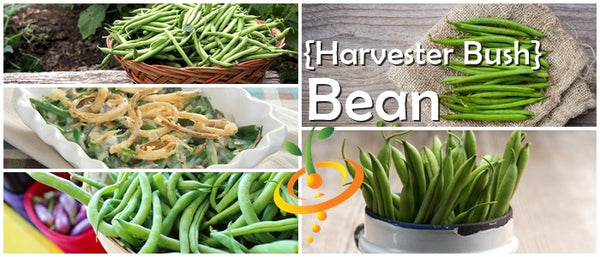
The Harvester Bush Bean grows high off the ground for easy picking. It has excellent flavor from pods that can grow up to 6" long. And you can be enjoying the juicy crunchiness in only 55 days. What’s not to like about this easy string bean?- Easy to grow
- High yielding
- Easy to harvest
- Long, flavorful pods
SEED PLANTING TIPS
- Botanical name: Phaseolus vulgaris
- Depth to plant seeds: 1" deep
- Spacing between plants: 4" apart
- Spacing between rows: 18"-24" apart
- Days to germinate (sprout): 5-10 days
- Germination soil temps: 70F-85F
- Soil needs: 6.0-7.0 pH
- Sun needs: Full sun
- Frost hardy: No
- Planting season: Spring, summer, fall
- # of plants per sq. ft.: Appx. 4 plants per sq. ft.
- Days to maturity: 50-55 days
Good companion plants: Cucumber, Pea, Rosemary, Thyme, Tomato
- From $199 USDUnit price /Unavailable
Description
The Jade Bush Bean produces very sweet, tender 7" pods. These stringless beans grow on a strong plant, high off the ground for quick picking, and their deep green color makes them easy to spot among the leaves. This gem maintains production even in high temperatures.
- Easy to grow
- Stringless variety
- Sweet, tender 7" pods
- Tolerates high temperatures
SEED PLANTING TIPS
- Botanical name: Phaseolus vulgaris
- Depth to plant seeds: 1" deep
- Spacing between plants: 4" apart
- Spacing between rows: 18"-24" apart
- Days to germinate (sprout): 5-10 days
- Germination soil temps: 70F-85F
- Soil needs: 6.0-7.0 pH
- Sun needs: Full sun
- Frost hardy: No
- Planting season: Spring, summer, fall
- # of plants per sq. ft.: Appx. 4 plants per sq. ft.
- Days to maturity: 55-60 days
Click here to view our full Bean grow guide
Good companion plants: Cucumber, Pea, Rosemary, Thyme, Tomato
- From $199 USDUnit price /Unavailable
Description

The Landreth Bush Bean is a classic green bean—lovely medium color, tender 5"-6" stringless pods, and excellent flavor. It’s also an heirloom that has been growing in gardens since the late 1800s. A reliable and heavy producer, this bean is more heat tolerant than other varieties. Tends to grow tall and wide, so give it a little more garden space.
- Easy to grow
- High yields
- Heat tolerant
- Stringless variety
SEED PLANTING TIPS
- Botanical name: Phaseolus vulgaris
- Depth to plant seeds: 1" deep
- Spacing between plants: 4"-6" apart
- Spacing between rows: 18"-24" apart
- Days to germinate (sprout): 5-10 days
- Germination soil temps: 70F-85F
- Soil needs: 6.0-7.0 pH
- Sun needs: Full sun
- Frost hardy: No
- Planting season: Spring, summer, fall
- # of plants per sq. ft.: Appx. 2-4 plants per sq. ft.
- Days to maturity: 50-55 days
Click here to view our full Bean grow guide
Good companion plants: Cucumber, Pea, Rosemary, Thyme, Tomato
- From $299 USDUnit price /Unavailable
Description

The Provider Bush Bean is great for all you impatient gardeners. It germinates in cool soil, so you can direct sow earlier than other beans, and matures in only 50 days. This high-yielding compact plant provides delicious 5"-6" stringless pods with purple beans inside.
- Germinates in cool soil
- Matures quickly—50 days
- Heavy producer
- Stringless variety
SEED PLANTING TIPS
- Botanical name: Phaseolus vulgaris
- Depth to plant seeds: 1" deep
- Spacing between plants: 4" apart
- Spacing between rows: 18"-24" apart
- Days to germinate (sprout): 5-10 days
- Germination soil temps: 60F-85F
- Soil needs: 6.0-7.0 pH
- Sun needs: Full sun
- Frost hardy: No
- Planting season: Spring, summer, fall
- # of plants per sq. ft.: Appx. 4 plants per sq. ft.
- Days to maturity: 50-55 days
Click here to view our full Bean grow guide
Good companion plants: Cucumber, Pea, Rosemary, Thyme, Tomato
- From $299 USDUnit price /Unavailable
Description
The Royal Burgundy Bush Bean has so many things going for it—colorful, beautiful, tasty, plentiful, long-producing—but the coolest thing is that it grows in cool weather. Dark purple 5"-6" pods produced high on the plant make for a doubly easy harvest. When cooked, watch them change color from royal purple to royal green.
- Easy to grow
- High yields
- Continuous production throughout growing season
- Grows in cool weather
SEED PLANTING TIPS
- Botanical name: Phaseolus vulgaris
- Depth to plant seeds: 1" deep
- Spacing between plants: 4" apart
- Spacing between rows: 18"-24" apart
- Days to germinate (sprout): 5-10 days
- Germination soil temps: 70F-85F
- Soil needs: 6.0-7.0 pH
- Sun needs: Full sun
- Frost hardy: No
- Planting season: Spring, summer, fall
- # of plants per sq. ft.: Appx. 4 plants per sq. ft.
- Days to maturity: 50-55 days
Click here to view our full Bean grow guide
Good companion plants: Cucumber, Pea, Rosemary, Thyme, Tomato
- From $199 USDUnit price /Unavailable
Description
The Slenderette Bush Bean is a sleek French-type green bean. A vigorous grower that produces high yields of slim 5" long stringless pods on a compact plant. This sweet, juicy, tender, crunchy bean would taste great in a European thin/thick bean salad served alongside wider Roma II Italian beans.
- Easy to grow
- Stringless variety
- Sweet, juicy, tender, and crunchy
- High yields
SEED PLANTING TIPS
- Botanical name: Phaseolus vulgaris
- Depth to plant seeds: 1" deep
- Spacing between plants: 4" apart
- Spacing between rows: 18"-24" apart
- Days to germinate (sprout): 5-10 days
- Germination soil temps: 70F-85F
- Soil needs: 6.0-7.0 pH
- Sun needs: Full sun
- Frost hardy: No
- Planting season: Spring, summer, fall
- # of plants per sq. ft.: Appx. 4 plants per sq. ft.
- Days to maturity: 50-55 days
Click here to view our full Bean grow guide
Good companion plants: Cucumber, Pea, Rosemary, Thyme, Tomato
- From $299 USDUnit price /Unavailable
Description
The Bean Taylor Dwarf plant, scientifically known as Phaseolus vulgaris, is a popular choice among gardeners due to its compact size and high yield. This variety is particularly well-suited for small gardens or container gardening, making it accessible for urban gardeners and those with limited space.
One of the defining characteristics of the Bean Taylor Dwarf is its growth habit. Typically, this plant reaches a height of approximately 18 to 24 inches, which allows for easy harvesting without the need for extensive bending or stretching. The dwarf nature of this plant also means that it can be planted closer together than taller varieties, maximizing space efficiency in the garden.
In terms of productivity, the Bean Taylor Dwarf is known for its prolific output. Under optimal growing conditions, a single plant can produce an impressive yield of beans, often exceeding 1 pound per plant. This makes it an excellent choice for home gardeners looking to supplement their vegetable intake with fresh produce.
The growing requirements for the Bean Taylor Dwarf are relatively straightforward. It thrives in well-drained soil with a pH level between 6.0 and 7.0. Full sun exposure is essential, as this plant requires at least 6 to 8 hours of sunlight daily to achieve optimal growth. Additionally, regular watering is crucial, particularly during dry spells, as beans are sensitive to drought conditions.
From a nutritional standpoint, beans are an excellent source of protein, fiber, and essential vitamins and minerals. The Bean Taylor Dwarf, like other bean varieties, contributes significantly to a balanced diet. It is particularly rich in folate, iron, and magnesium, making it a valuable addition to any meal plan.
When considering pest management, the Bean Taylor Dwarf may be susceptible to common garden pests such as aphids and spider mites. Implementing integrated pest management strategies, including the use of beneficial insects and organic pesticides, can help mitigate these issues while promoting a healthy garden ecosystem.
In conclusion, the Bean Taylor Dwarf plant is a versatile and productive option for gardeners seeking to grow their own food. Its compact size, high yield, and nutritional benefits make it an excellent choice for both novice and experienced gardeners alike. By understanding its growing requirements and potential challenges, gardeners can successfully cultivate this plant and enjoy the fruits of their labor.
Click here to view our full Bean grow guide
Good companion plants: Cucumber, Pea, Rosemary, Thyme, Tomato
- From $299 USDUnit price /Unavailable
Description

The Tendergreen Bush Bean is a heavy yielder and heat-tolerant, producing longer than other beans. It grows long 6"-7" stringless pods, but pick them at 5" for best flavor and tenderness. Be sure to shell one of the pods to see the purple-brown beans inside.
- Easy to grow
- High yields
- Heat tolerant
- Stringless variety
SEED PLANTING TIPS
- Botanical name: Phaseolus vulgaris
- Depth to plant seeds: 1" deep
- Spacing between plants: 4" apart
- Spacing between rows: 18"-24" apart
- Days to germinate (sprout): 5-10 days
- Germination soil temps: 70F-85F
- Soil needs: 6.0-7.0 pH
- Sun needs: Full sun
- Frost hardy: No
- Planting season: Spring, summer, fall
- # of plants per sq. ft.: Appx. 4 plants per sq. ft.
- Days to maturity: 50-55 days
Click here to view our full Bean grow guide
Good companion plants: Cucumber, Pea, Rosemary, Thyme, Tomato
- From $199 USDUnit price /Unavailable
Description
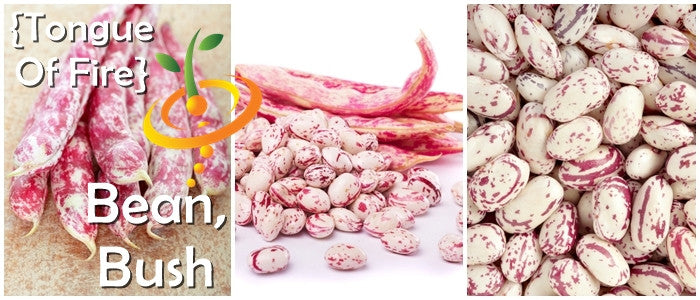
Not only does the Tongue of Fire Bush Bean have one of the best names for a vegetable, this Italian heirloom bean produces beautiful, flavorful wide cranberry streaked pods. Originally collected in Tierra del Fuego on the tip of South America, it produces 6"-7" long pods on a compact plant. Eat it young as a green bean, shell it when it matures, or let it dry and cook the large beans as you would kidney beans.
- Easy to grow
- High yielding
- Beautiful and delicious
- 6"-7" long pods
SEED PLANTING TIPS
- Botanical name: Phaseolus vulgaris
- Depth to plant seeds: 1" deep
- Spacing between plants: 4" apart
- Spacing between rows: 18"-24" apart
- Days to germinate (sprout): 5-10 days
- Germination soil temps: 70F-85F
- Soil needs: 6.0-7.0 pH
- Sun needs: Full sun
- Frost hardy: No
- Planting season: Spring, summer, fall
- # of plants per sq. ft.: Appx. 4 plants per sq. ft.
- Days to maturity: 55-90 days
Click here to view our full Bean grow guide
Good companion plants: Cucumber, Pea, Rosemary, Thyme, Tomato
- From $199 USDUnit price /Unavailable
Description
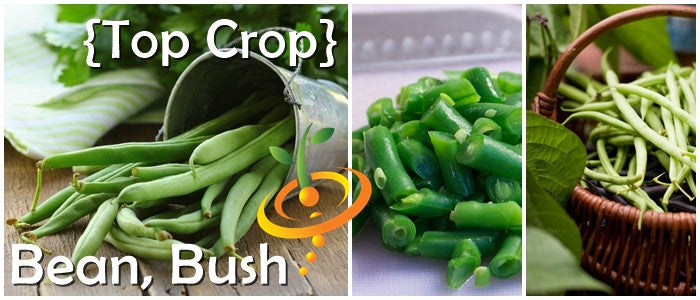
The Top Crop Bush Bean lives up to its name. This All-American Selections (AAS) winner produces high yields high up on a tall plant for easy harvesting. The 6"-7" pods are smooth, round, straight, and stringless, and they mature early in about 50 days. Also add heat tolerant to the list.
- Easy to grow
- Easy to harvest
- Heat tolerant
- Matures early—50 days
SEED PLANTING TIPS
- Botanical name: Phaseolus vulgaris
- Depth to plant seeds: 1" deep
- Spacing between plants: 4" apart
- Spacing between rows: 18"-24" apart
- Days to germinate (sprout): 5-10 days
- Germination soil temps: 70F-85F
- Soil needs: 6.0-7.0 pH
- Sun needs: Full sun
- Frost hardy: No
- Planting season: Spring, summer, fall
- # of plants per sq. ft.: Appx. 4 plants per sq. ft.
- Days to maturity: 50-55 days
Click here to view our full Bean grow guide
Good companion plants: Cucumber, Pea, Rosemary, Thyme, Tomato
- From $299 USDUnit price /Unavailable
Description
The Aguadulce Fava Bean is a cold hardy broadbean that can also take a bit of heat. This 4' bush-type plant produces charming white and black flowers that turn into huge green pods with huge, creamy, nutty, protein-rich beans inside. Known as a dried bean, it’s also delicious when eaten fresh from the pod. With its edible leaves, high yields, and nitrogen-fixing properties, this is a gorgeous performer for fall and winter gardens in all grow zones.
- Easy to grow
- Cold hardy to 20 degrees F
- Nitrogen fixer
- Great for winter gardens
SEED PLANTING TIPS
- Botanical name: Vicia faba
- Depth to plant seeds: 2" deep
- Spacing between plants: 4"-6" apart
- Spacing between rows: 18"-24" apart
- Days to germinate (sprout): 10-14 days
- Germination soil temps: 50F-65F
- Soil needs: 6.0-7.0 pH
- Sun needs: Full sun
- Frost hardy: Yes
- Planting season: Spring, fall, winter
- # of plants per sq. ft.: Appx. 2-4 plants per sq. ft.
- Days to maturity: 75-80 days when spring sown, 180 days when fall sown
Click here to view our full Bean grow guide
Good companion plants: Cabbage, Carrot, Lettuce, Parsley, Rosemary
Bean, Fava/Broad - Broad Windsor
From $299 USDUnit price /UnavailableDescription

Consumed around the world as a nutritious, protein-rich dried bean, The Broad Windsor Fava Bean is also tasty as a shell bean. This cold hardy bush-type plant grows to 3'-4' with unusual black and white blossoms. The huge beans have a creamy, nutty flavor, and the leaves can be eaten fresh or cooked. High yields make this nitrogen fixer a multi-tasker in the fall and winter gardens of all grow zones.
- Easy to grow
- Cold hardy to 20 degrees
- Nitrogen fixer
- Great for winter gardens
SEED PLANTING TIPS
- Botanical name: Vicia faba
- Depth to plant seeds: 2" deep
- Spacing between plants: 4"-6" apart
- Spacing between rows: 18"-24" apart
- Days to germinate (sprout): 10-14 days
- Germination soil temps: 50F-65F
- Soil needs: 6.0-7.0 pH
- Sun needs: Full sun
- Frost hardy: Yes
- Planting season: Spring, fall, winter
- # of plants per sq. ft.: Appx. 2-4 plants per sq. ft.
- Days to maturity: 75-80 days when spring sown, 180 days when fall sown
Click here to view our full Bean grow guide.
Good companion plants: Cabbage, Carrot, Lettuce, Parsley, Rosemary
- From $199 USDUnit price /Unavailable
Description
View all bean seeds
The Thorogreen Lima Bean is a high-yielding heirloom that loves higher temperatures. Plump, light green pods grow at the top of a compact plant for easy harvesting. Both fresh and dried beans have a smooth, buttery flavor. When eating fresh, be sure to cook them, as raw beans are toxic. This compact bush-type plant spreads wider than green beans, so give them room to grow.
- Easy to grow
- Bush growth habit
- Heat loving
- Early producer
SEED PLANTING TIPS
- Botanical name: Phaseolus lunatus
- Depth to plant seeds: 1.5" deep
- Spacing between plants: 6"-8" apart
- Spacing between rows: 24"-30" apart
- Days to germinate (sprout): 10-21 days
- Germination soil temps: 70F-90F
- Soil needs: 6.0-7.0 pH
- Sun needs: Full sun
- Frost hardy: No
- Planting season: Spring, summer, fall
- # of plants per sq. ft.: Appx. 2-4 plants per sq. ft.
- Days to maturity: 65-75 days
Click here to view our full Bean grow guide
Good companion plants: Cucumber, Pea, Rosemary, Thyme, Tomato
Bean, Lima/Pole - King of the Garden
From $199 USDUnit price /UnavailableDescription

With a name like King of the Garden Lima Bean, you can expect great things. This pole bean produces prolific yields of 7" pods full of large white lima beans with sweet, smooth flavor. Vines can grow 9'-10' high. Will continue to blossom and produce throughout the hot summer months. Cook them before you eat them fresh, as raw lima beans are toxic.
- Easy to grow
- Prolific producer
- Heat loving
- Sweet flavor
SEED PLANTING TIPS
- Botanical name: Phaseolus lunatus
- Depth to plant seeds: 1.5" deep
- Spacing between plants: 4"-5" apart
- Spacing between rows: 24"-30" apart
- Days to germinate (sprout): 10-21 days
- Germination soil temps: 70F-90F
- Soil needs: 6.0-7.0 pH
- Sun needs: Full sun
- Frost hardy: No
- Planting season: Spring, summer
- # of plants per sq. ft.: Appx. 4-6 plants per sq. ft.
- Days to maturity: 85-95 days
Click here to view our full Bean grow guide
Good companion plants: Cucumber, Pea, Rosemary, Thyme, Tomato
Bean, Pole - Asparagus Yard-Long
From $199 USDUnit price /UnavailableDescription
The Red-Seeded Asparagus Yard-Long Pole Bean says it all—very long asparagus-green and -flavored pods with red beans inside, except it grows to only half its claim. Also called Snake Bean or Chinese Long Bean, but why use half the words, too? Thank goodness it’s stringless, or you’d spend all day stringing pods in the heat that it loves. Vigorous vines can grow to 12'. For best umami flavor, harvest when 8"-12" long and the width of a pencil.
- Easy to grow
- Stringless variety
- Heat loving
- Umami flavor
SEED PLANTING TIPS
- Botanical name: Phaseolus vulgaris
- Depth to plant seeds: 1" deep
- Spacing between plants: 5" apart
- Spacing between rows: 18"-24" apart
- Days to germinate (sprout): 8-14 days
- Germination soil temps: 70F-90F
- Soil needs: 6.0-7.0 pH
- Sun needs: Full sun
- Frost hardy: No
- Planting season: Spring, summer
- # of plants per sq. ft.: Appx. 4 plants per sq. ft.
- Days to maturity: 75-85 days
Click here to view our full Bean grow guide
Good companion plants: Cucumber, Pea, Rosemary, Thyme, Tomato
Bean, Pole - Kentucky Wonder, Brown
From $299 USDUnit price /UnavailableDescription

The Kentucky Wonder Brown-Seeded Pole Bean is a reliable and heavy yielder. This vigorous vining plant produces bright green, stringless 8" pods with flavorful brown beans inside. Wondering if you can get flavorful white beans inside? Yes, you can. Quick to start producing, and will continue to set blooms and beans until frost.
- Easy to grow
- Long 8" pods
- Quick to produce
- Long growing season
SEED PLANTING TIPS
- Botanical name: Phaseolus vulgaris
- Depth to plant seeds: 1" deep
- Spacing between plants: 5" apart
- Spacing between rows: 18"-24" apart
- Days to germinate (sprout): 8-14 days
- Germination soil temps: 70F-90F
- Soil needs: 6.0-7.0 pH
- Sun needs: Full sun
- Frost hardy: No
- Planting season: Spring, summer
- # of plants per sq. ft.: Appx. 4 plants per sq. ft.
- Days to maturity: 75-85 days
Click here to view our full Bean grow guide
Good companion plants: Cucumber, Pea, Rosemary, Thyme, Tomato
Bean, Pole - Kentucky Wonder, White
From $149 USDUnit price /UnavailableDescription

The Kentucky Wonder White-Seeded Pole Bean is one of the oldest and most widely enjoyed bean varieties ever grown. It produces reliably heavy yields of 6"-8" long green pods with white beans inside. If you prefer brown beans, we sell those too. These stringless beans grow high off the ground for easy harvesting.
- Easy to grow
- Prolific producer
- Long pods up to 8"
- Stringless variety
SEED PLANTING TIPS
- Botanical name: Phaseolus vulgaris
- Depth to plant seeds: 1" deep
- Spacing between plants: 4" apart
- Spacing between rows: 18"-24" apart
- Days to germinate (sprout): 5-10 days
- Germination soil temps: 70F-85F
- Soil needs: 6.0-7.0 pH
- Sun needs: Full sun
- Frost hardy: No
- Planting season: Spring, summer, fall
- # of plants per sq. ft.: Appx. 4 plants per sq. ft.
- Days to maturity: 55-60
Click here to view our full Bean grow guide
Good companion plants: Cucumber, Pea, Rosemary, Thyme, Tomato
- From $199 USDUnit price /Unavailable
Description
The Purple Podded Pole Bean produces a profuse plurality of purely purple pods. View this variety vegetate vigorous verdant vines with violet developments. Stringless shells surround savory seeds.
- Easy to grow
- High yielding
- Long pods up to 7"
- Easy to harvest
SEED PLANTING TIPS
- Botanical name: Phaseolus vulgaris
- Depth to plant seeds: 1" deep
- Spacing between plants: 5" apart
- Spacing between rows: 18"-24" apart
- Days to germinate (sprout): 8-14 days
- Germination soil temps: 70F-85F
- Soil needs: 6.0-7.0 pH
- Sun needs: Full sun
- Frost hardy: No
- Planting season: Spring, summer
- # of plants per sq. ft.: Appx. 4 plants per sq. ft.
- Days to maturity: 70-75 days
Click here to view our full Bean grow guide
Good companion plants: Cucumber, Pea, Rosemary, Thyme, Tomato
- From $199 USDUnit price /Unavailable
Description
The Rattlesnake Pole Bean is as delicious as it is beautiful. Long purple-and-green streaked pods dangle from strong 10' vines, with streaked beige beans inside. Like its namesnake, it’s not bothered by heat, humidity, or drought. If you hear it rattle, it has probably dried on the vine. Grow alongside other streaked beans, like Tongue of Fire and Borlotti.
- Easy to grow
- Heat tolerant
- Long pods up to 8"-10”
- Eat fresh or dried
SEED PLANTING TIPS
- Botanical name: Phaseolus vulgaris
- Depth to plant seeds: 1" deep
- Spacing between plants: 5" apart
- Spacing between rows: 18"-24" apart
- Days to germinate (sprout): 8-14 days
- Germination soil temps: 70F-85F
- Soil needs: 6.0-7.0 pH
- Sun needs: Full sun
- Frost hardy: No
- Planting season: Spring, summer
- # of plants per sq. ft.: Appx. 4 plants per sq. ft.
- Days to maturity: 70-75 days
Click here to view our full Bean grow guide
Good companion plants: Cucumber, Pea, Rosemary, Thyme, Tomato
- From $099 USDUnit price /Unavailable
Description

The Romano Pole Bean is a traditional Italian heirloom bean enjoyed by generations of gardeners. The vining plant produces high yields of flat, wide, stringless 6" pods that taste best when harvested young. Just a great all-around green bean.
- Easy to grow
- Stringless variety
- Harvest young for best flavor
- Vining plant requires staking
SEED PLANTING TIPS
- Botanical name: Phaseolus vulgaris
- Depth to plant seeds: 1" deep
- Spacing between plants: 5" apart
- Spacing between rows: 18"-24" apart
- Days to germinate (sprout): 8-14 days
- Germination soil temps: 70F-85F
- Soil needs: 6.0-7.0 pH
- Sun needs: Full sun
- Frost hardy: No
- Planting season: Spring, summer, fall
- # of plants per sq. ft.: Appx. 4 plants per sq. ft.
- Days to maturity: 65-80 days
Click here to view our full Bean grow guide
Good companion plants: Cucumber, Pea, Rosemary, Thyme, Tomato
Bean, Runner/Pole - Prizewinner
From $199 USDUnit price /UnavailableDescription

The Prizewinner Runner Pole Bean produces a blue-ribbon show of crimson blossoms that transform into succulent, flavorful foot-long pods with speckled purple-red beans inside. Pick young for snap beans and mature for shell beans, or give them more time on stage and use them dried. A prolific producer that will win first, second, and third prize in your garden.- Easy to grow
- High yields
- Long pods up to 12"
- Eat fresh, shelled, or dried
SEED PLANTING TIPS
- Botanical name: Phaseolus coccineus
- Depth to plant seeds: 1" deep
- Spacing between plants: 5" apart
- Spacing between rows: 18"-24" apart
- Days to germinate (sprout): 8-14 days
- Germination soil temps: 70F-85F
- Soil needs: 6.0-7.0 pH
- Sun needs: Full sun
- Frost hardy: No
- Planting season: Spring, summer
- # of plants per sq. ft.: Appx. 4 plants per sq. ft.
- Days to maturity: 80-115 days
Click here to view our full Bean grow guide.
Good companion plants: Cucumber, Pea, Rosemary, Thyme, Tomato
Shop more:
BUSH BEANS
FAVA & BROAD BEANS
LIMA BEANS
POLE BEANS
continue shopping
YOU MAY ALSO LIKE
View all-
$27999 USD
$29999Unit price /Unavailable -
All-in-One Heritage Tomato Garden Variety Pack
$3999 USD$4499Unit price /Unavailable -
All-in-One Mosquito Repellent Garden Variety Pack
$3999 USDUnit price /Unavailable -
All-in-One Medicinal Herb Garden Seed Bank
$9999 USDUnit price /Unavailable -
All-in-One Pepper Garden Variety Pack
$3999 USDUnit price /Unavailable -
All-in-One Chicken Garden Variety Pack
$3999 USDUnit price /Unavailable -
All-in-One Lettuce & Leafy Greens Variety Pack
$3999 USDUnit price /Unavailable -
All-in-One Culinary Herb Garden Variety Pack
$3999 USDUnit price /Unavailable -
All-in-One Homestead Seed Bank
$9999 USDUnit price /Unavailable -
All-in-One Medicinal Herb Garden Variety Pack
$4999 USDUnit price /Unavailable -
All-in-One Root Crop Garden Variety Pack
$3999 USDUnit price /Unavailable -
All-in-One Fall/Winter Variety Pack
$3999 USDUnit price /Unavailable -
All-in-One Sprouts/Microgreens Variety Pack
$3499 USDUnit price /Unavailable -
All-in-One Hydroponic Greens Variety Pack
$3999 USDUnit price /Unavailable -
All-in-One Fall/Winter Seed Bank
$8999 USDUnit price /Unavailable -
All-in-One Sprouts/Microgreens Seed Bank w/Sprouting Jar
$6999 USD$7999Unit price /Unavailable -
All-in-One Culinary Herb Garden Seed Bank
$8999 USDUnit price /Unavailable -
All-in-One Spring/Summer Seed Bank
$8999 USDUnit price /Unavailable -
All-in-One Urban Garden Variety Pack
$3999 USDUnit price /Unavailable -
All-in-One Cucumber Garden Variety Pack
$2999 USDUnit price /Unavailable -
*NEW!* Wildflower Scatter Garden Variety Pack
$3999 USDUnit price /Unavailable -
All-in-One SAVE THE BEES! Garden Variety Pack
$3999 USDUnit price /Unavailable -
All-in-One Salsa Garden Variety Pack
$3999 USDUnit price /Unavailable -
All-in-One Tower Garden Variety Pack
$3999 USDUnit price /Unavailable
FEATURED COLLECTIONS
View allcontinue shopping



































































































































































































































